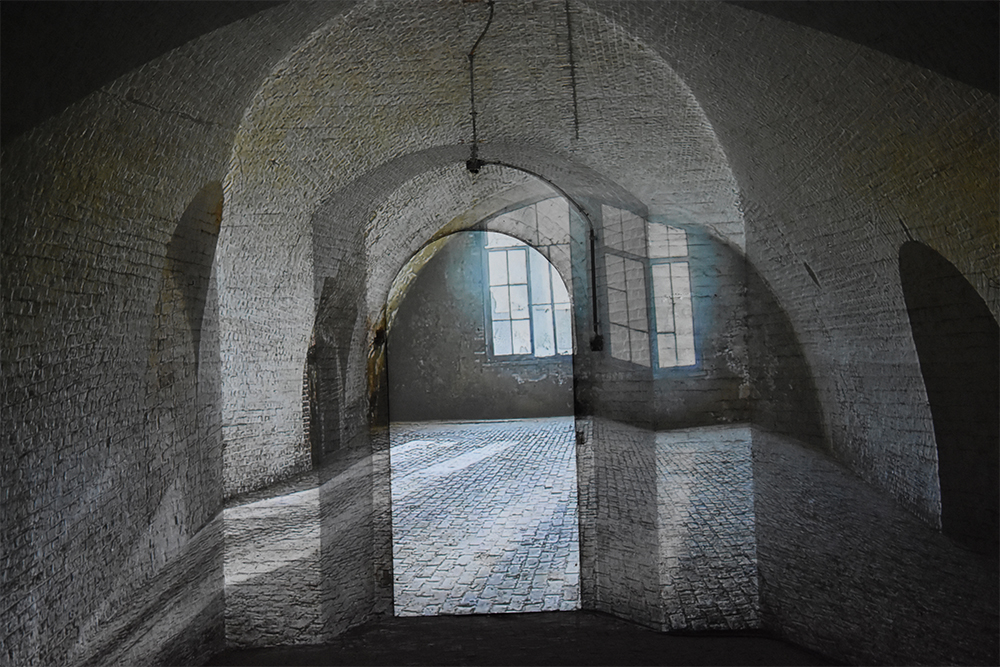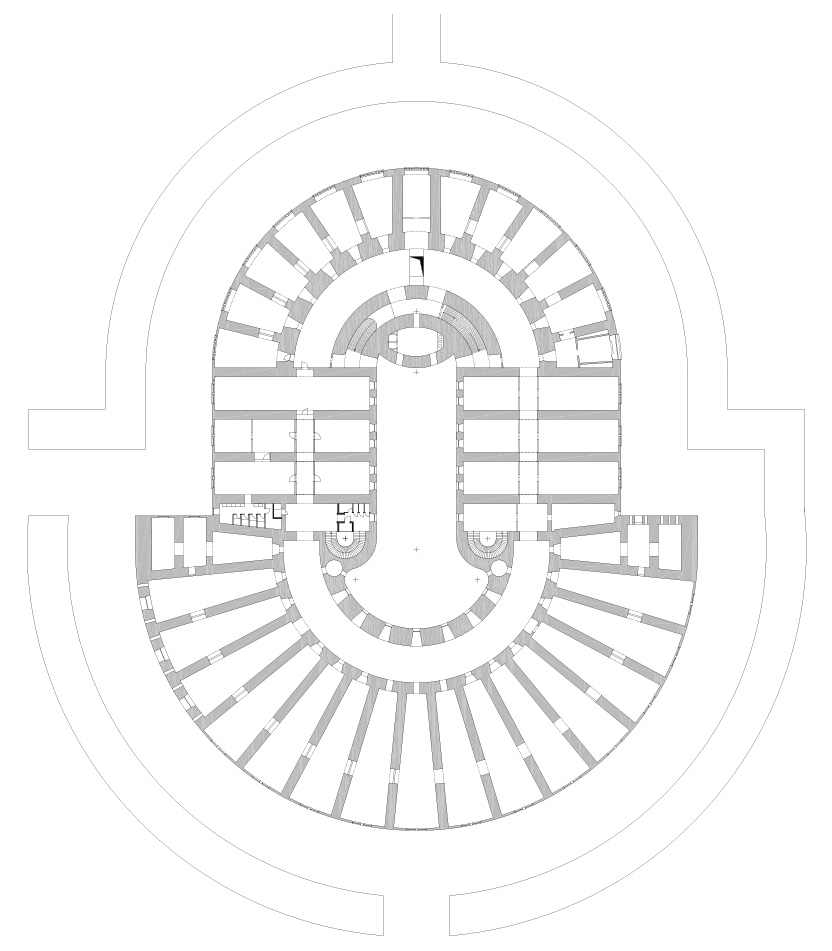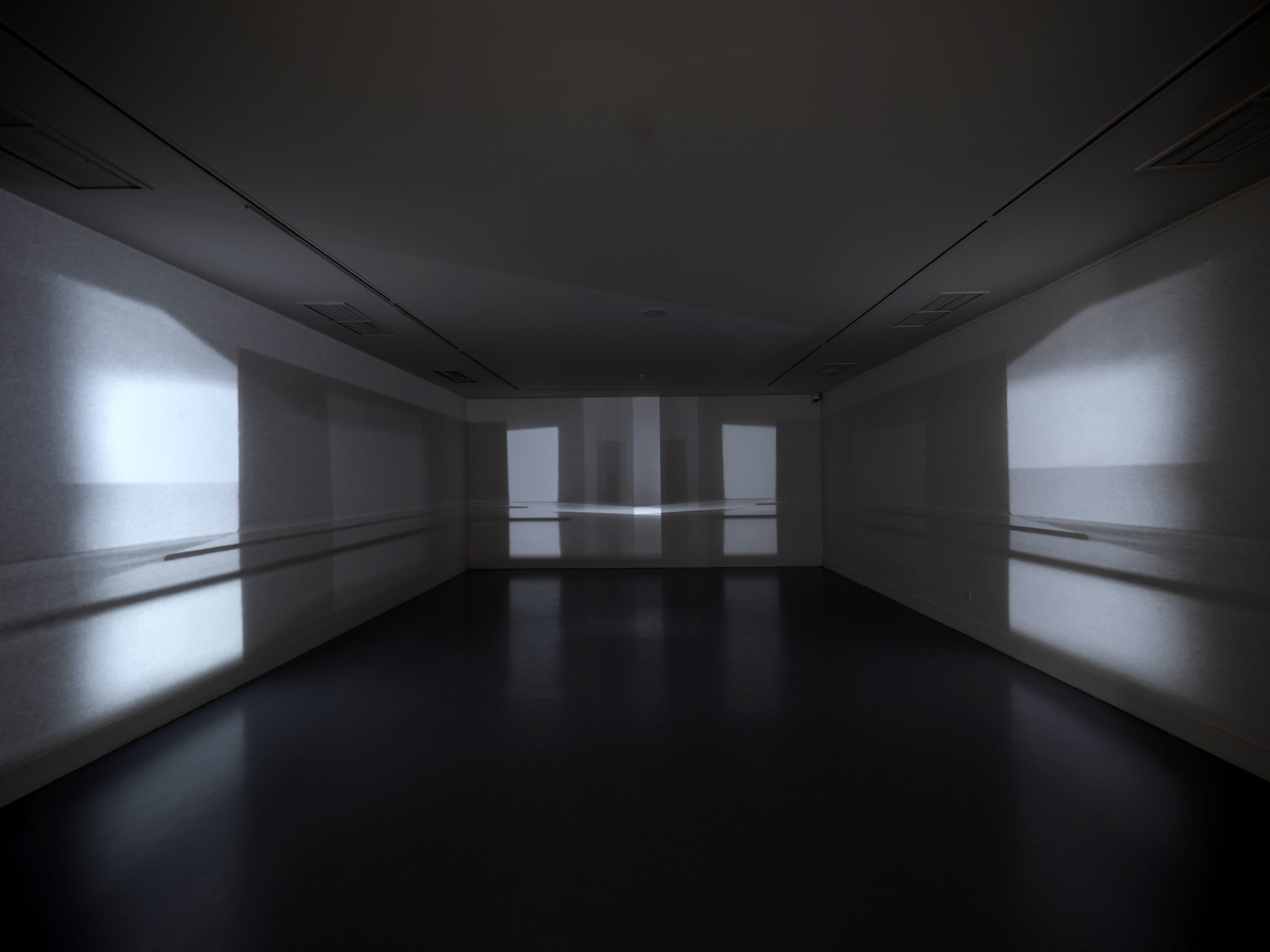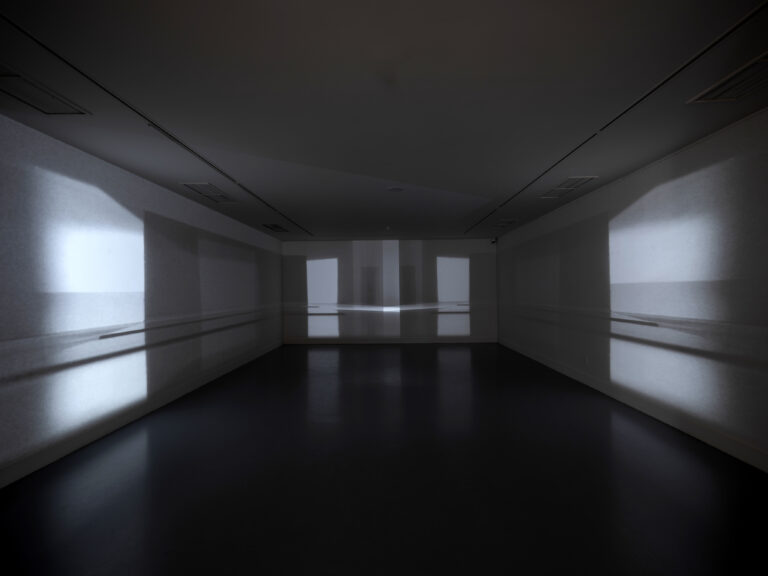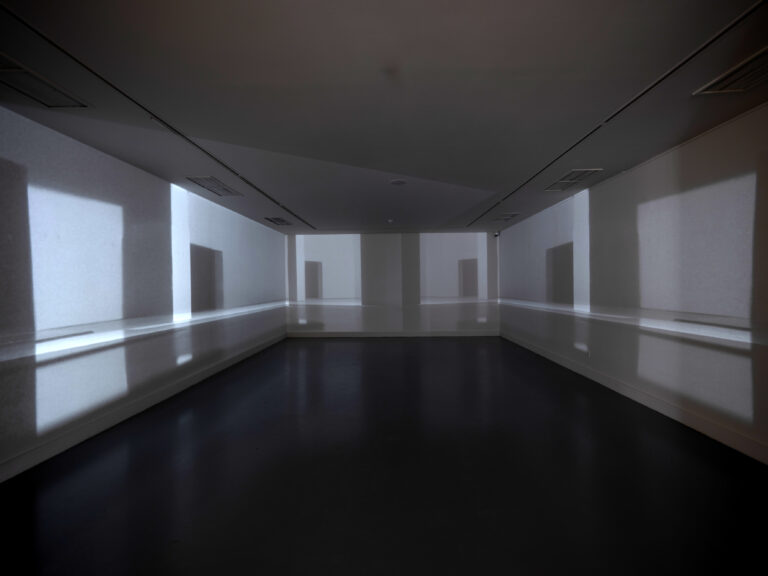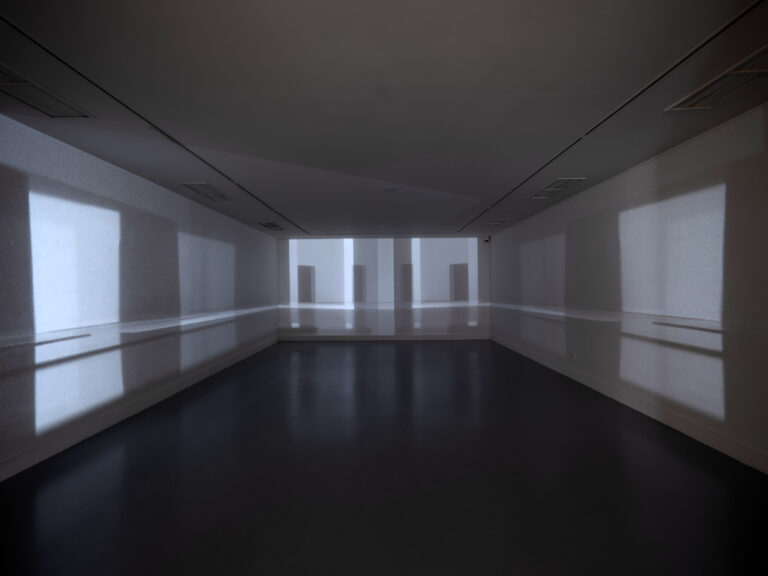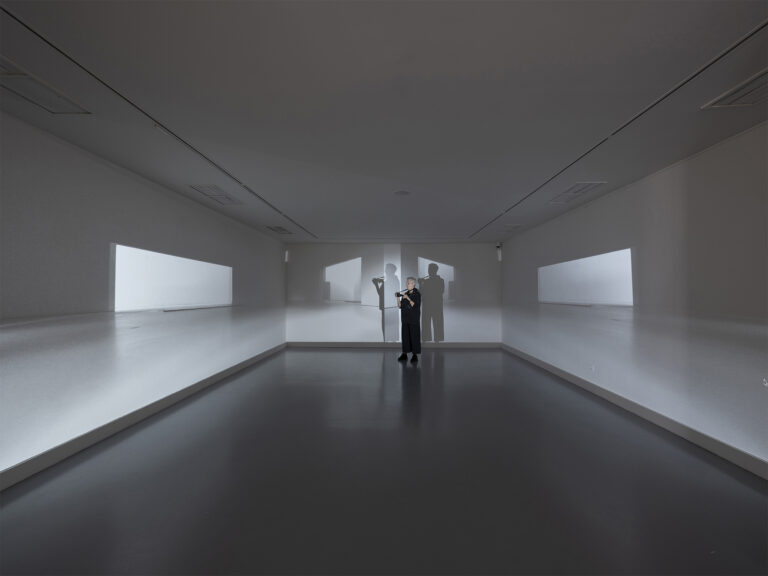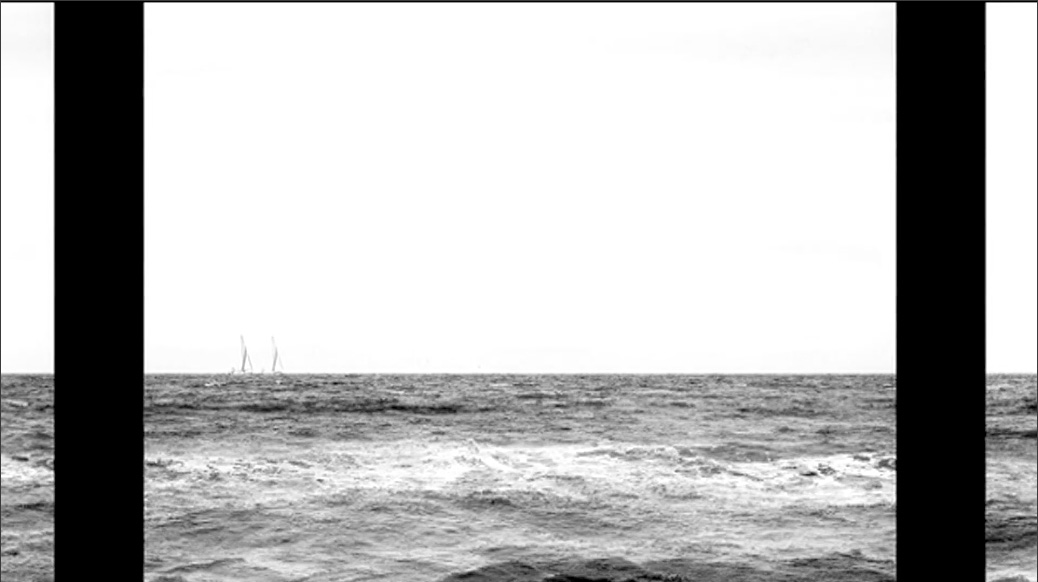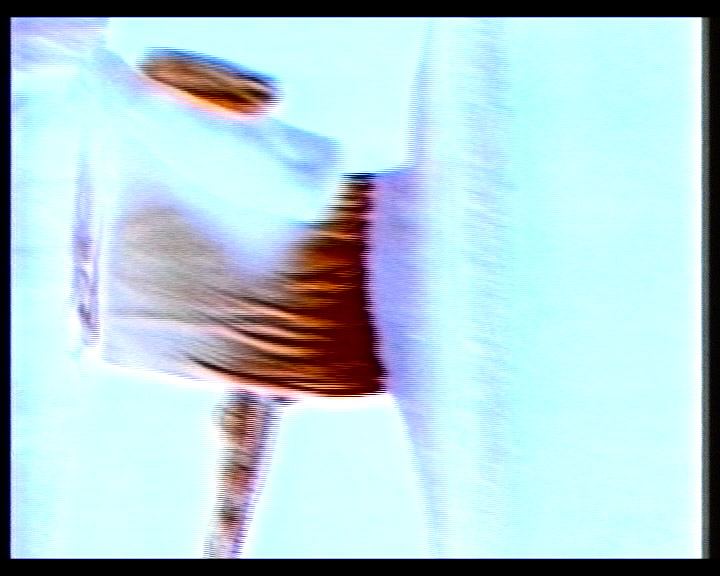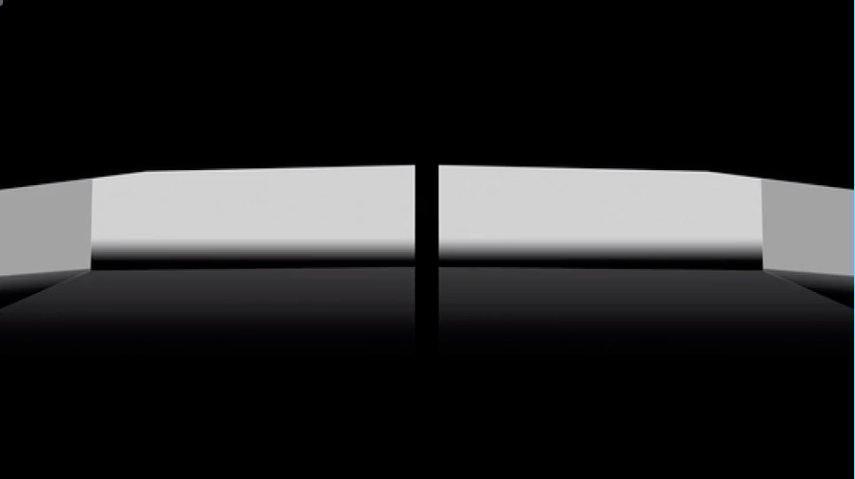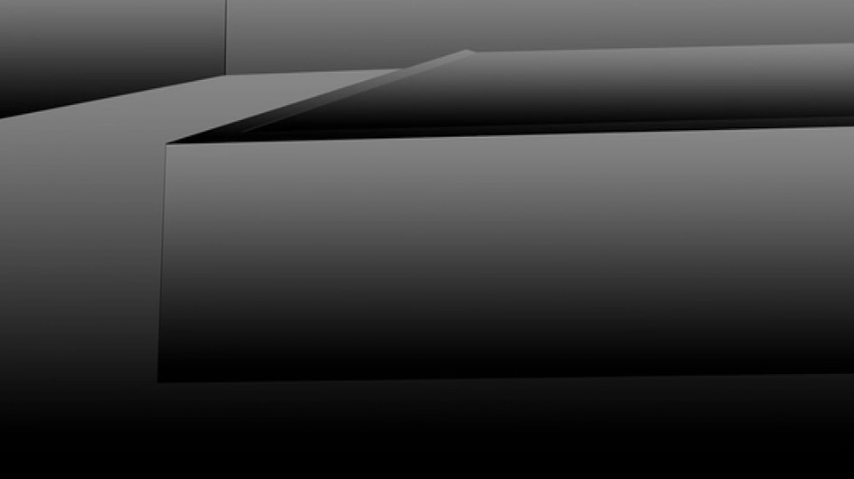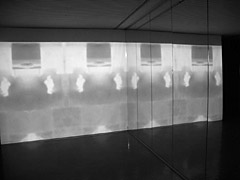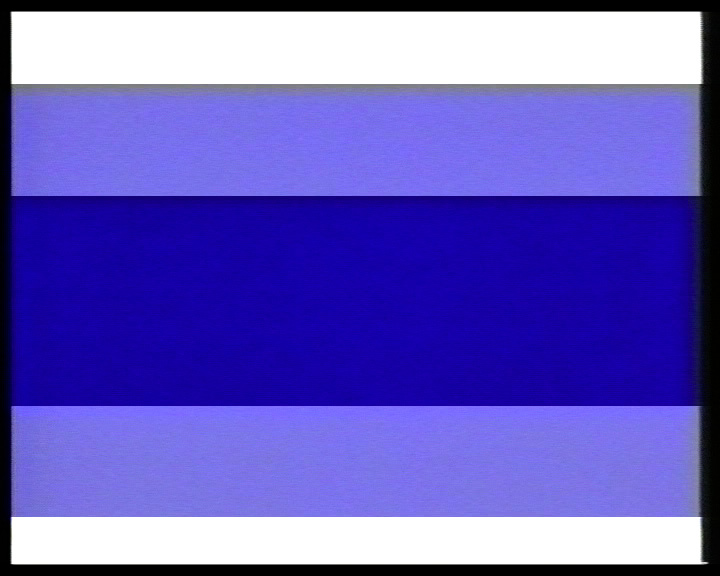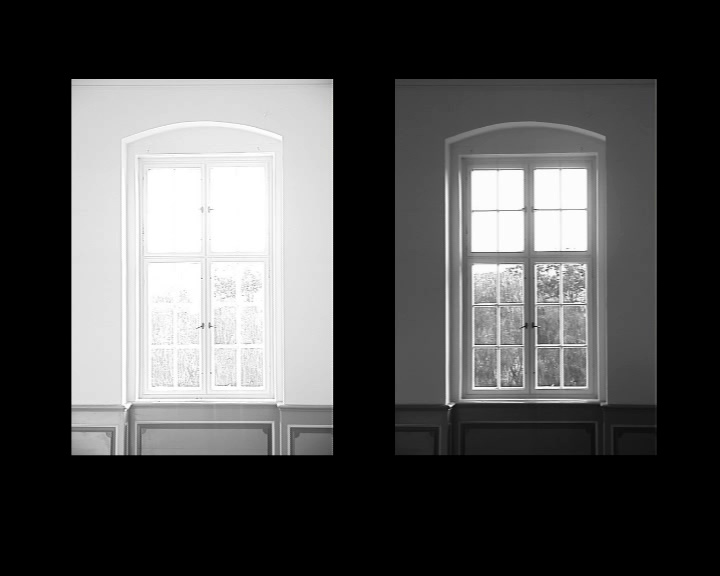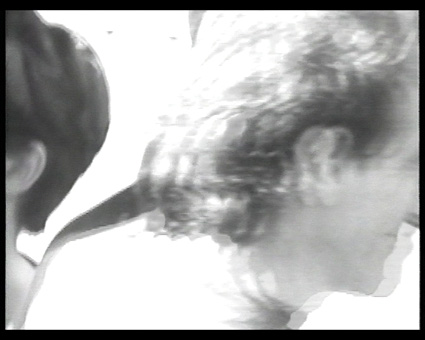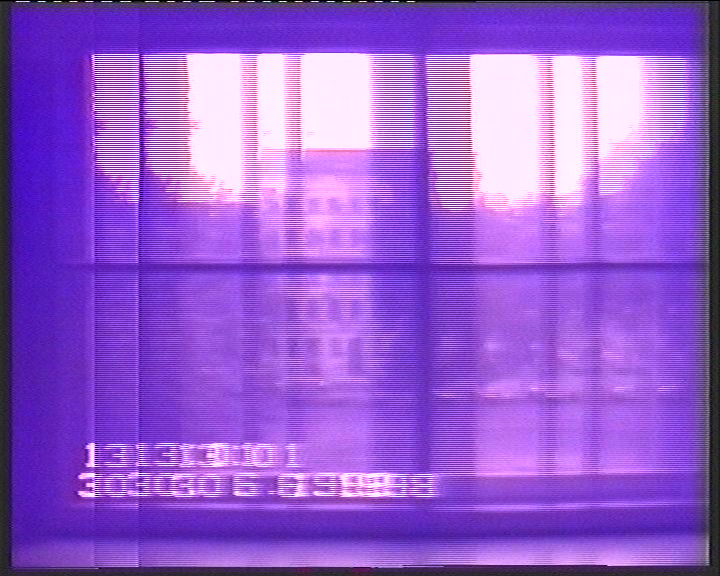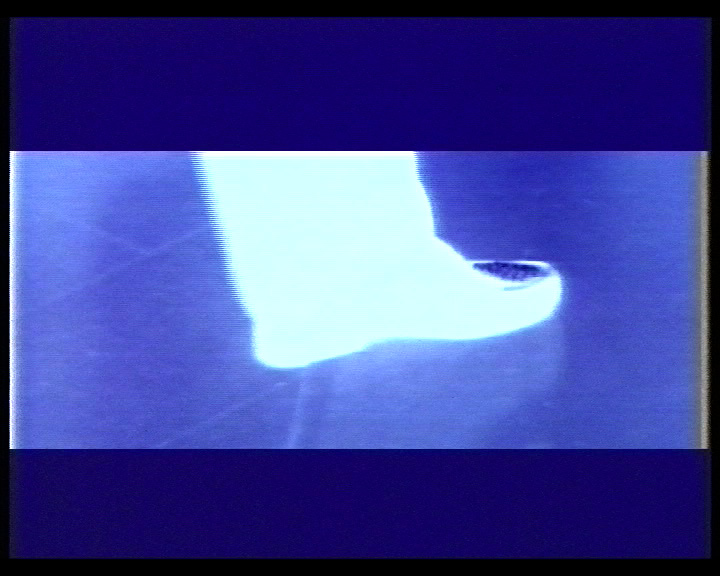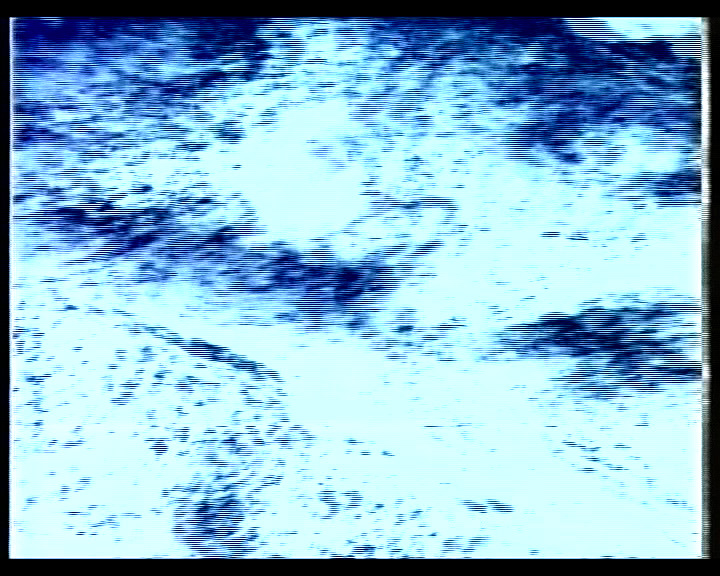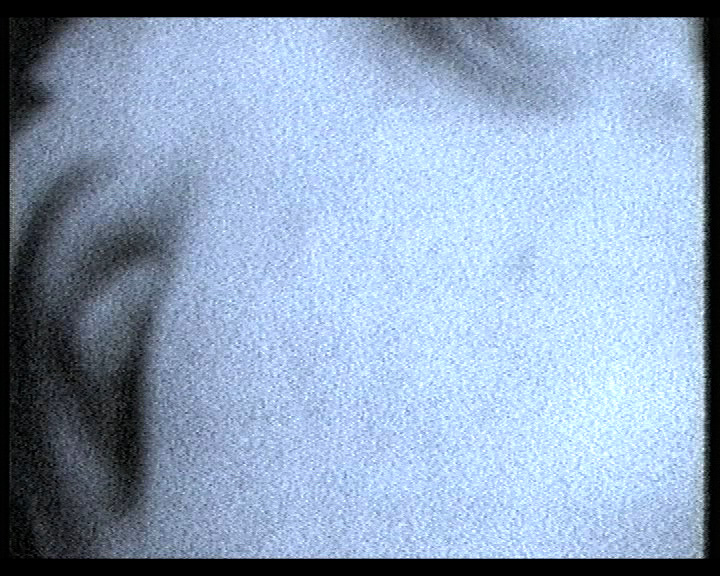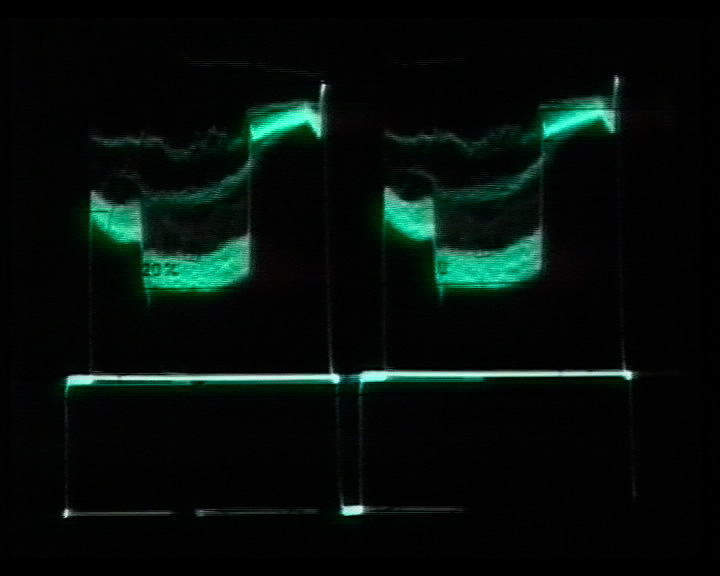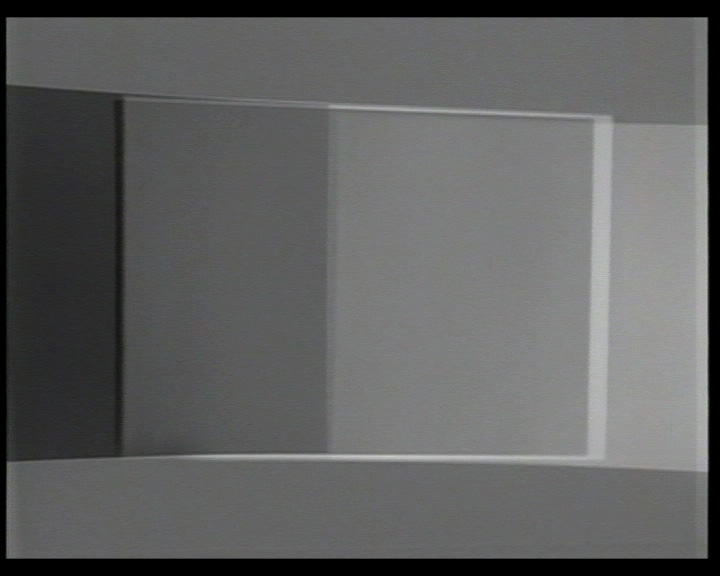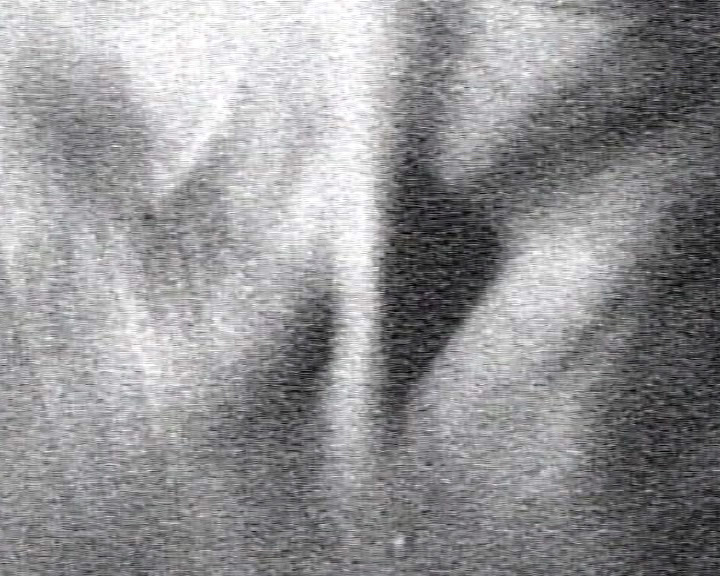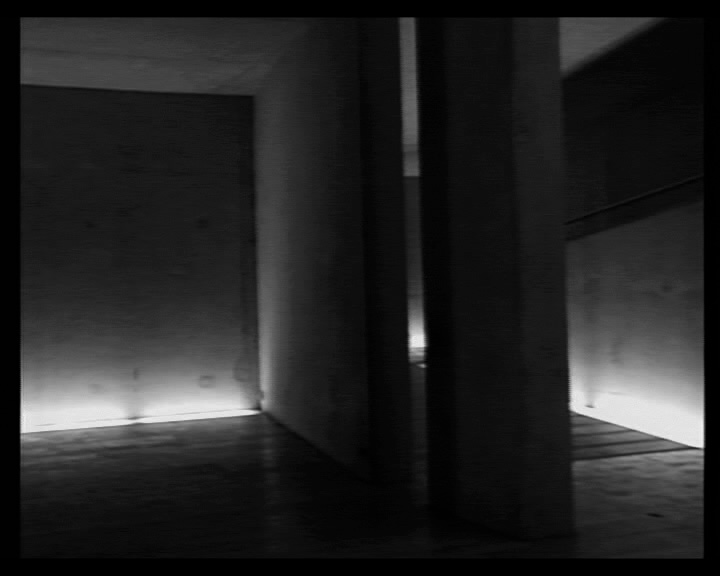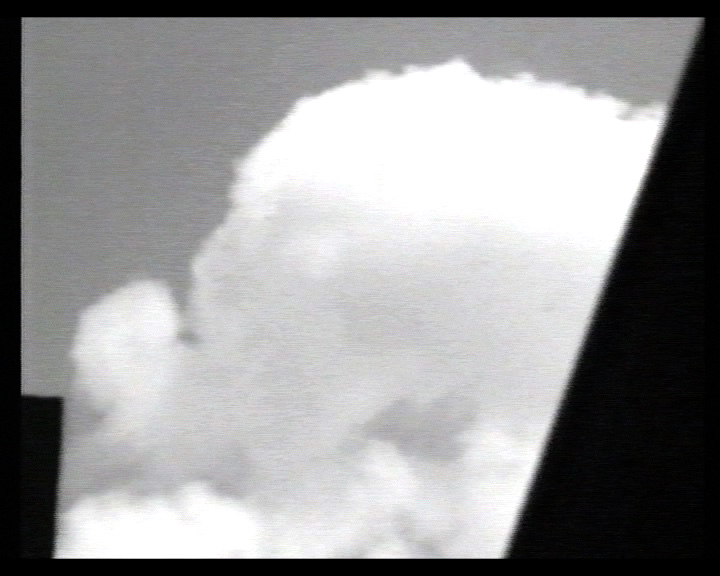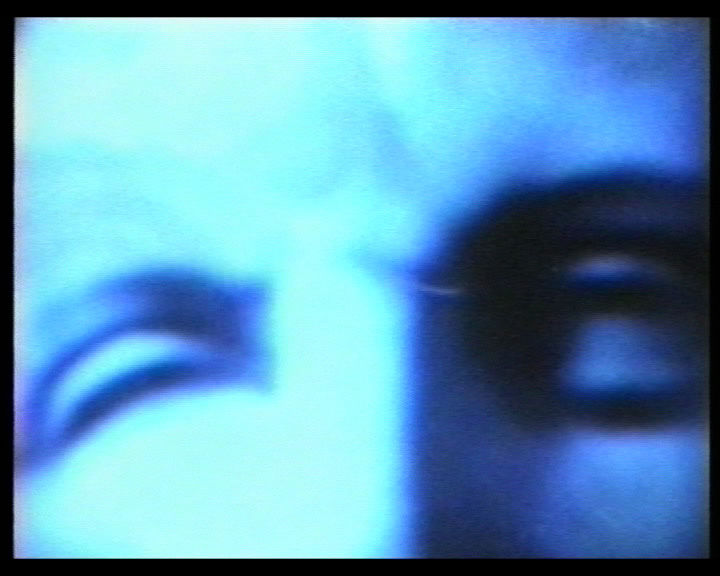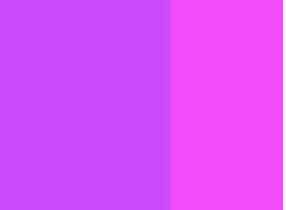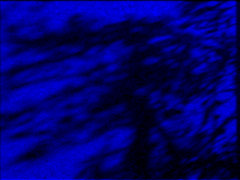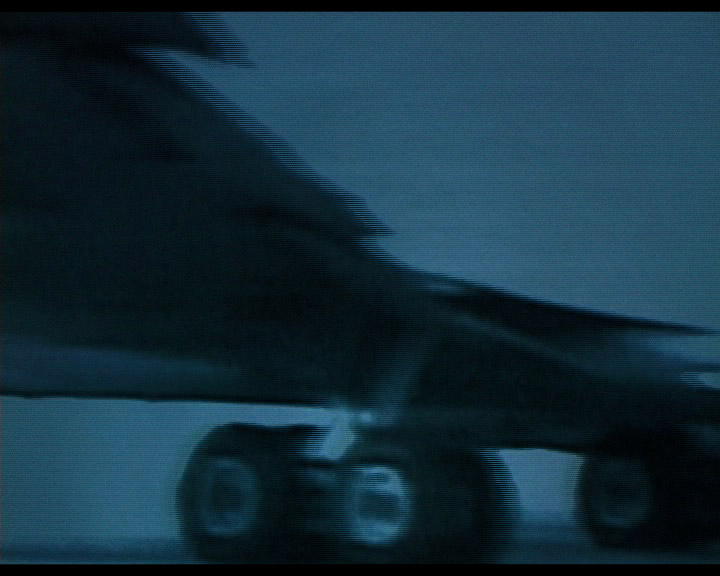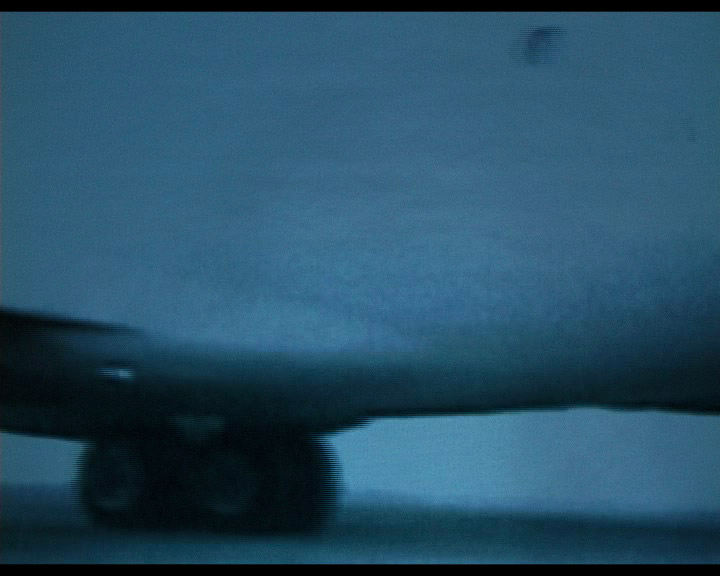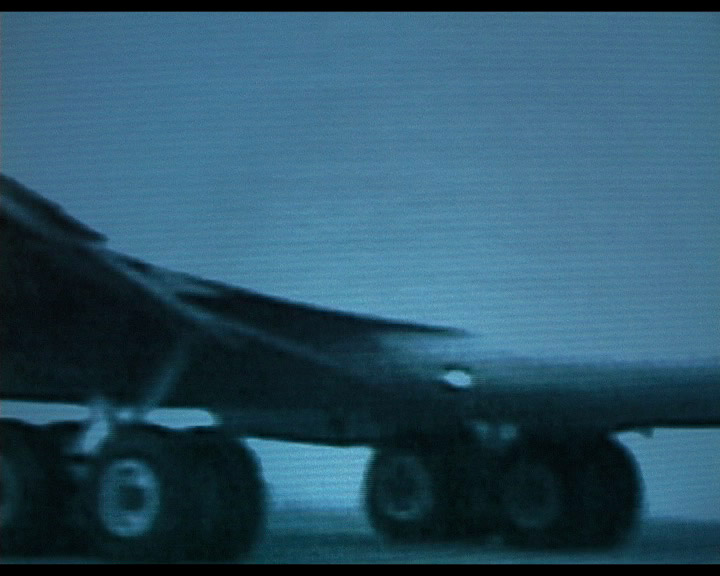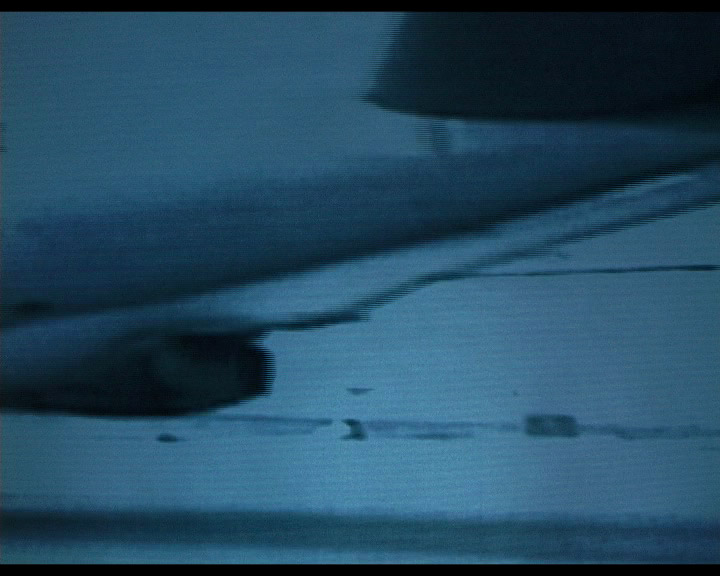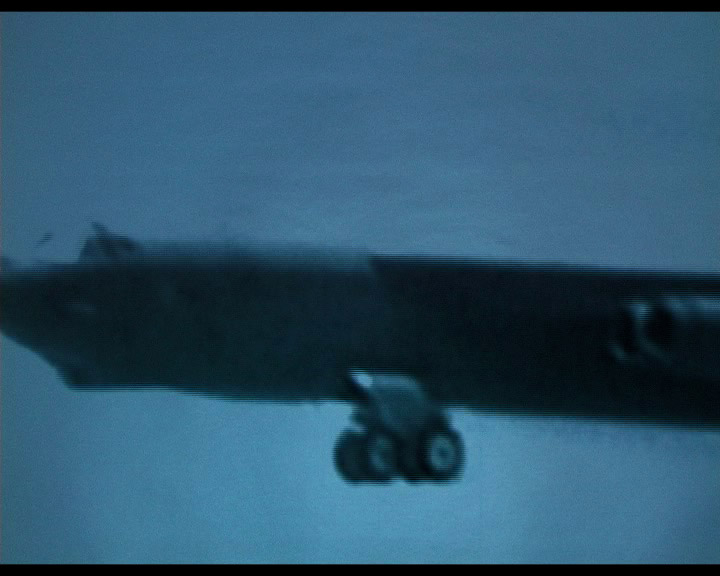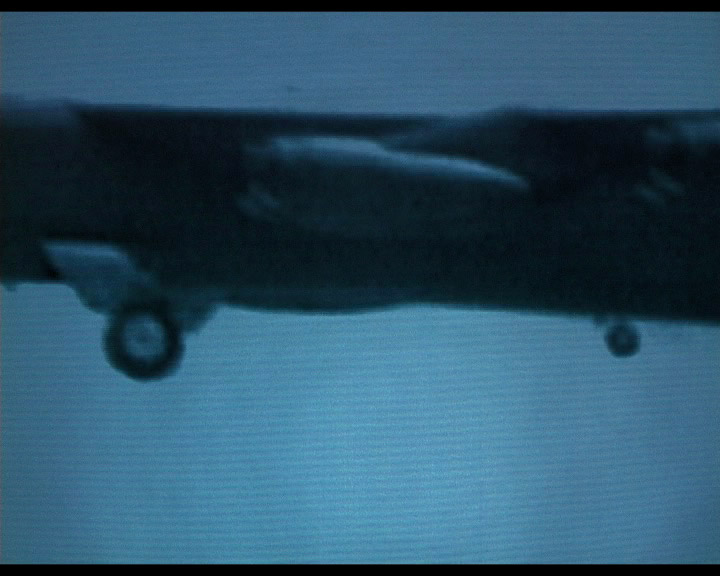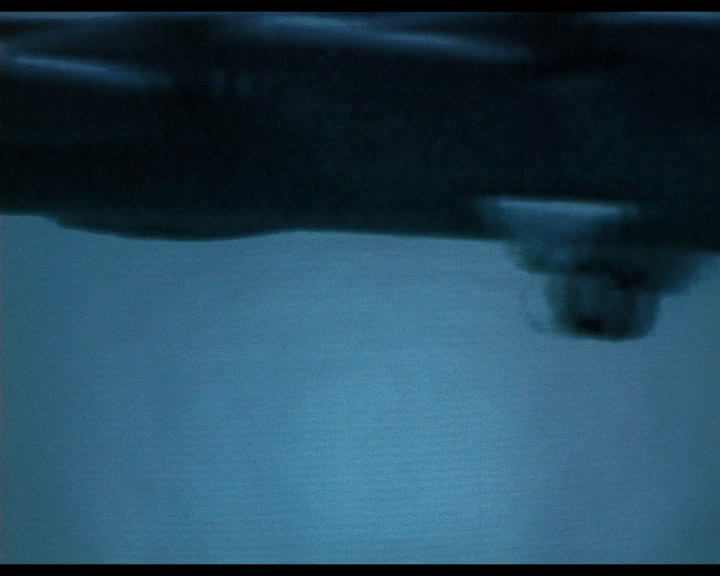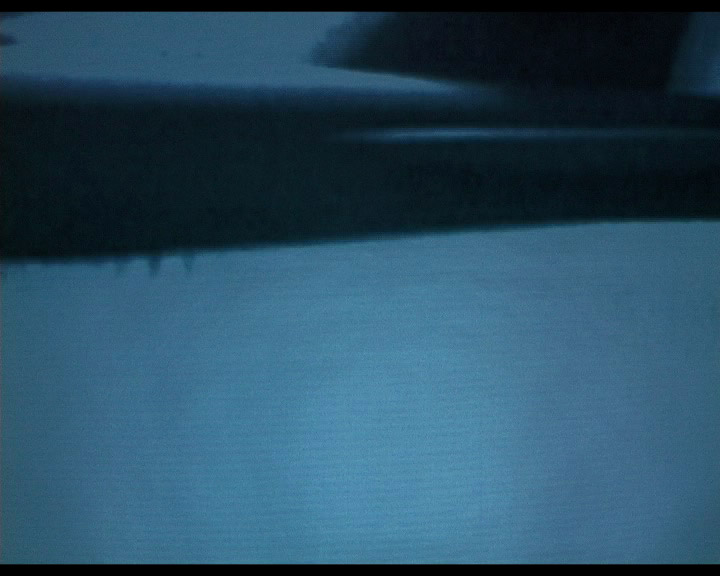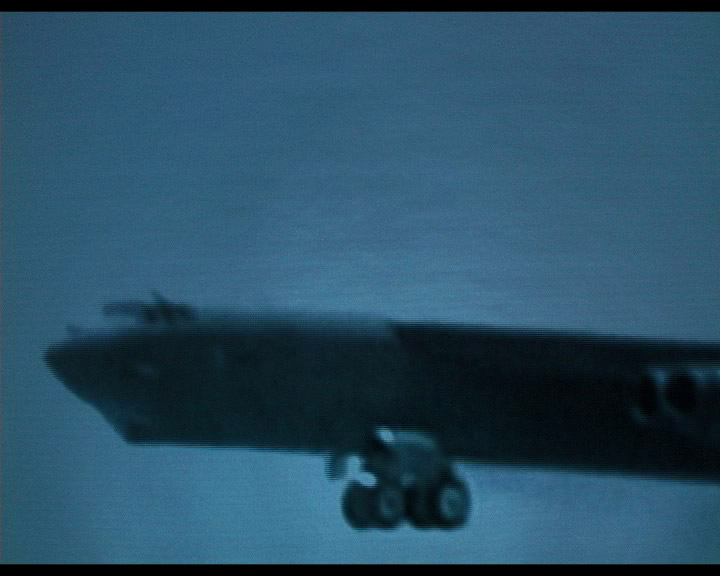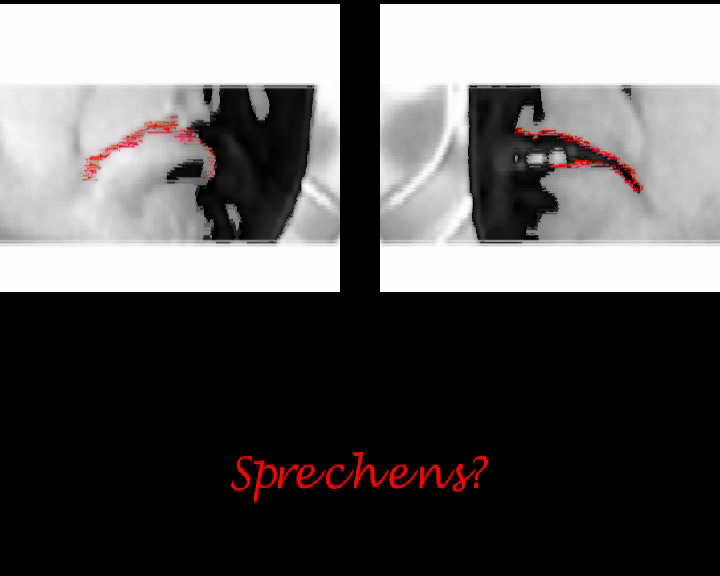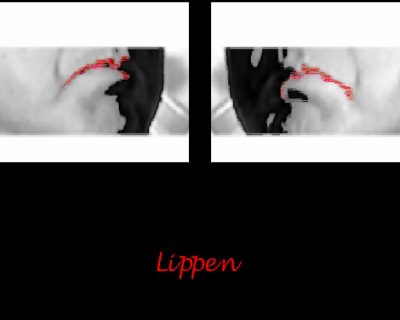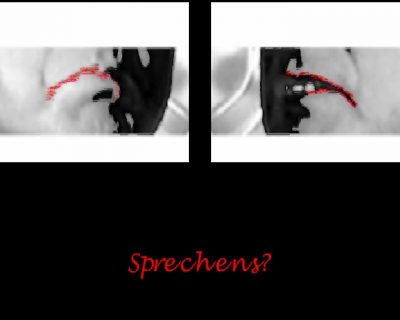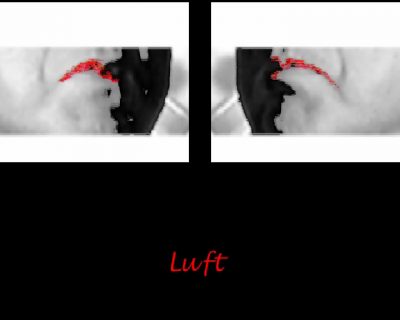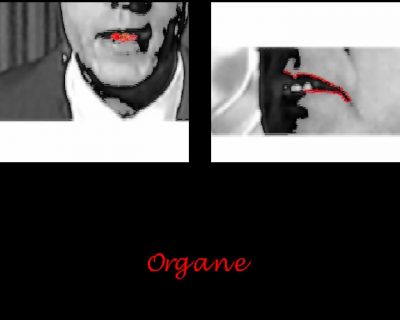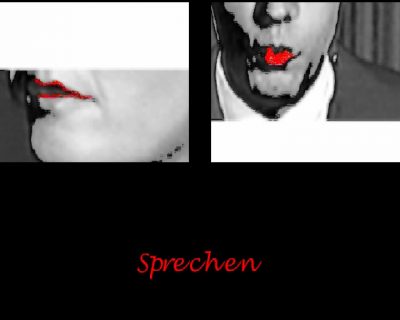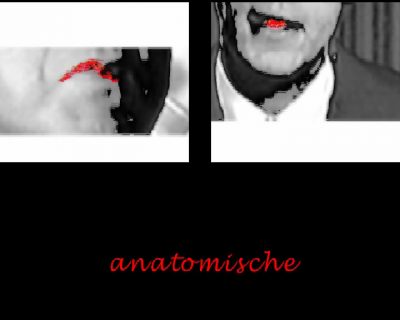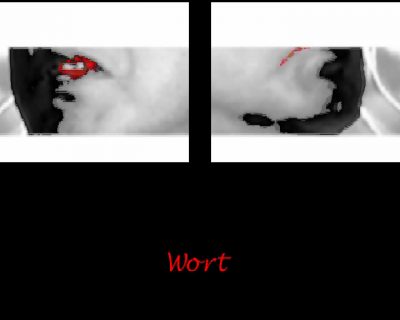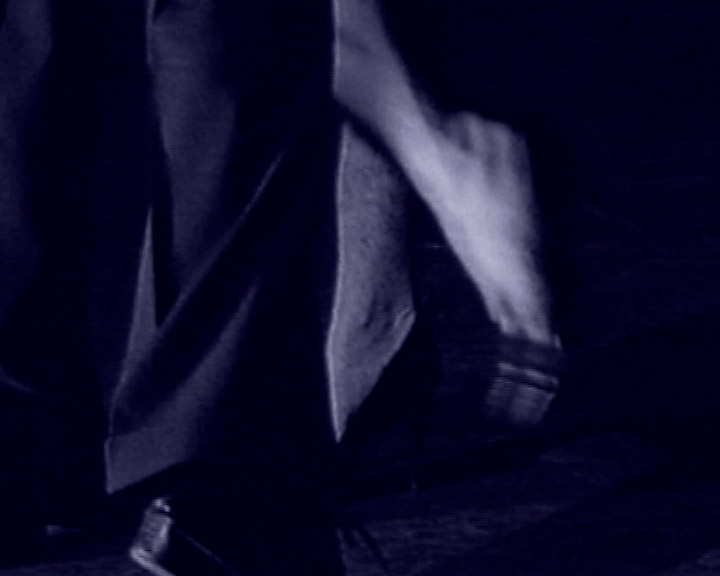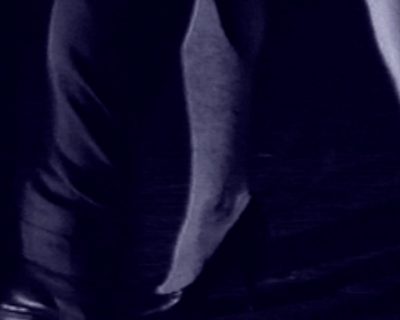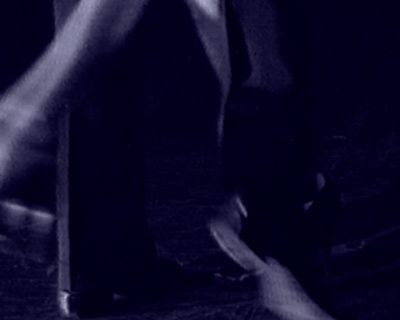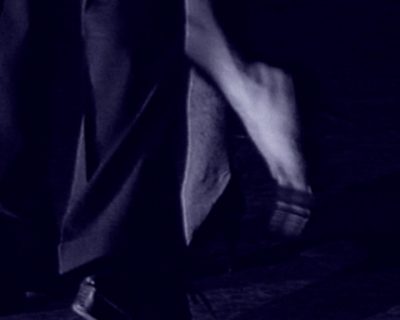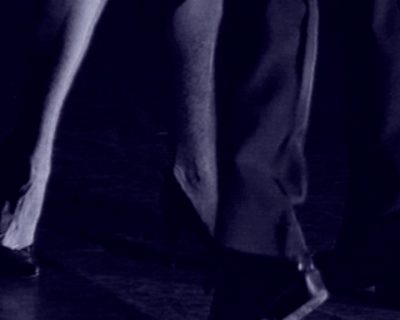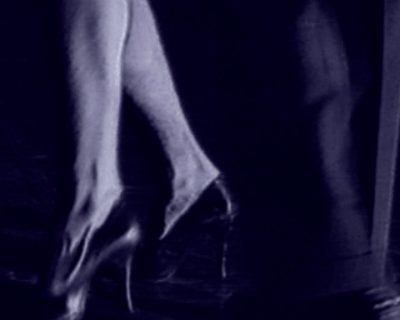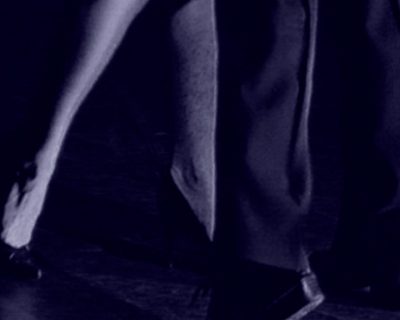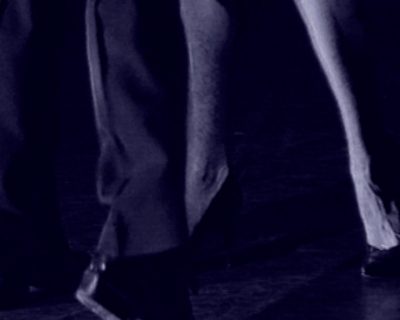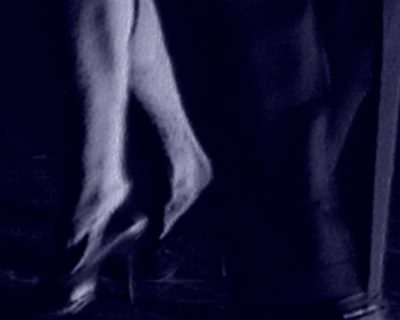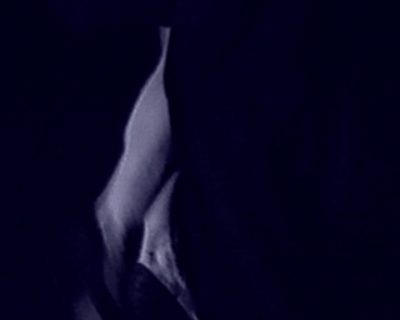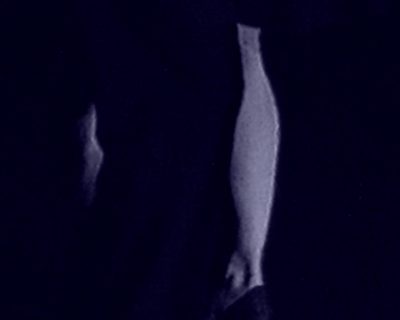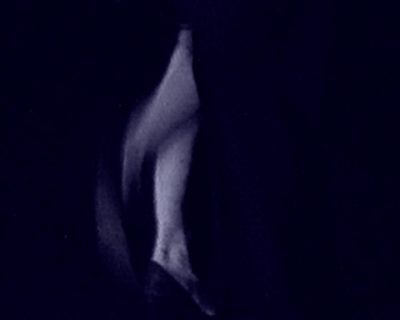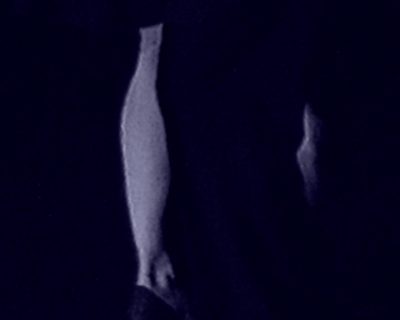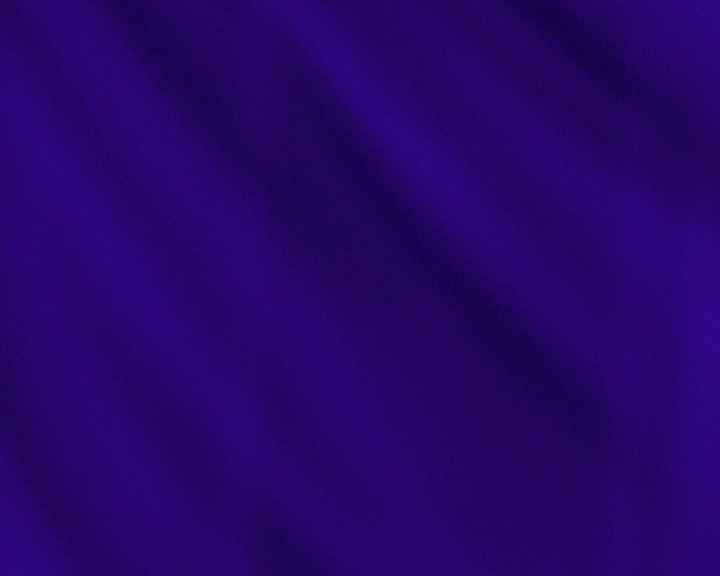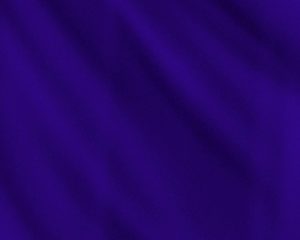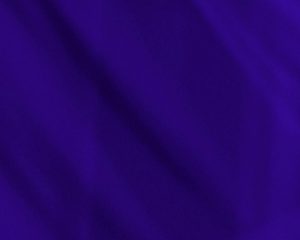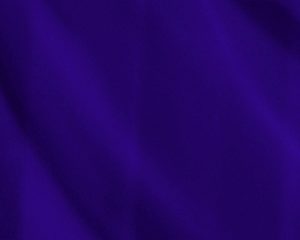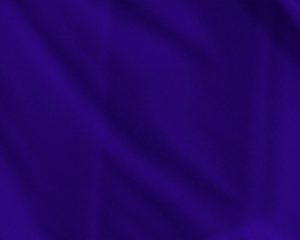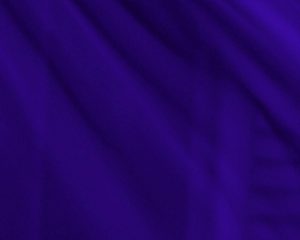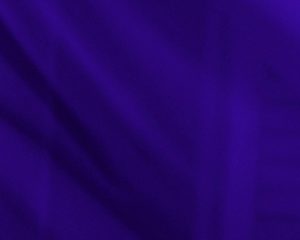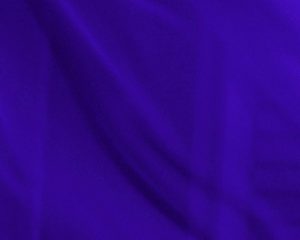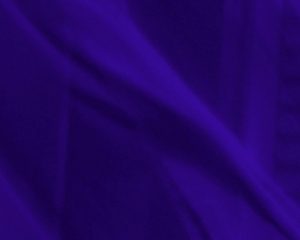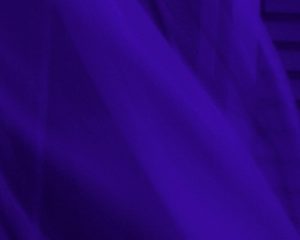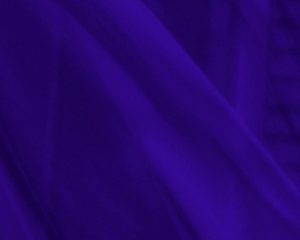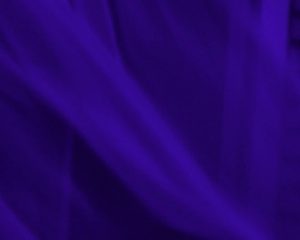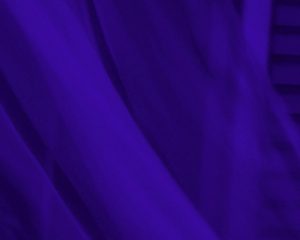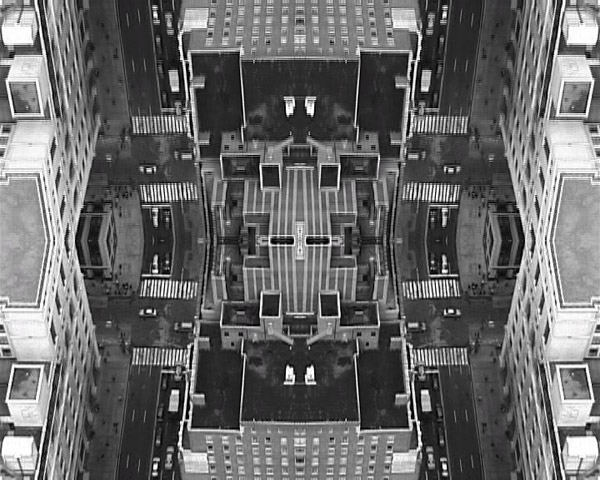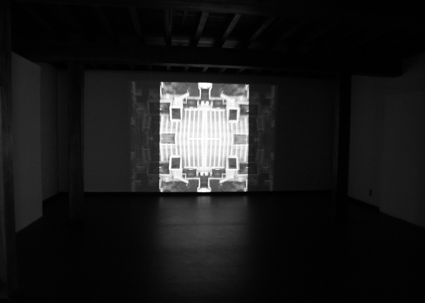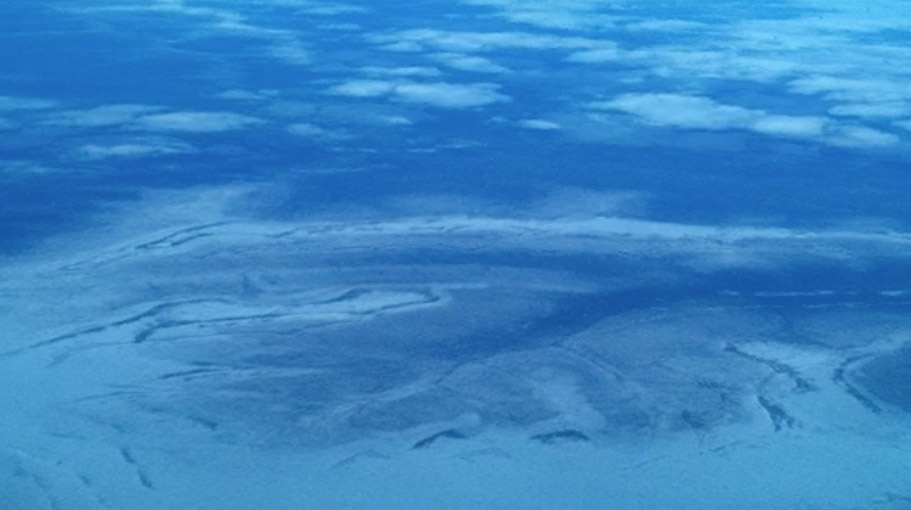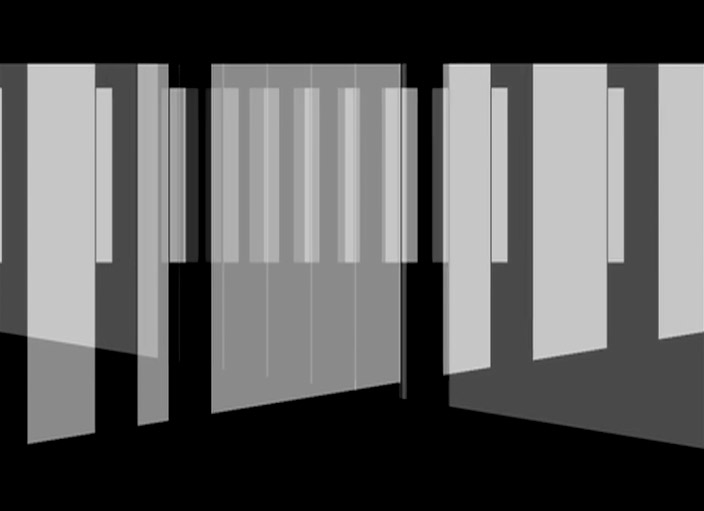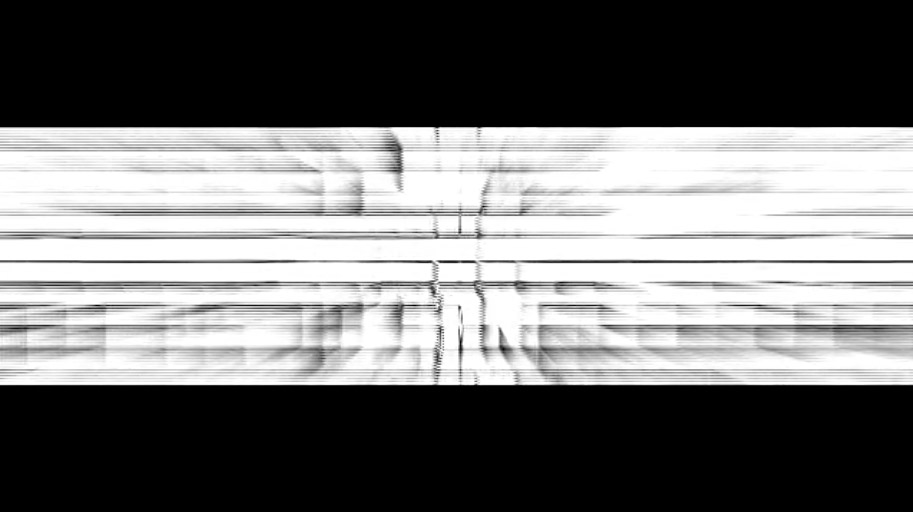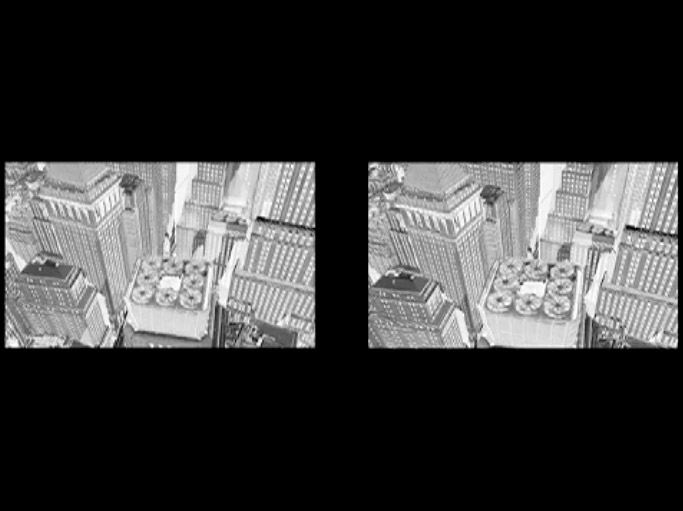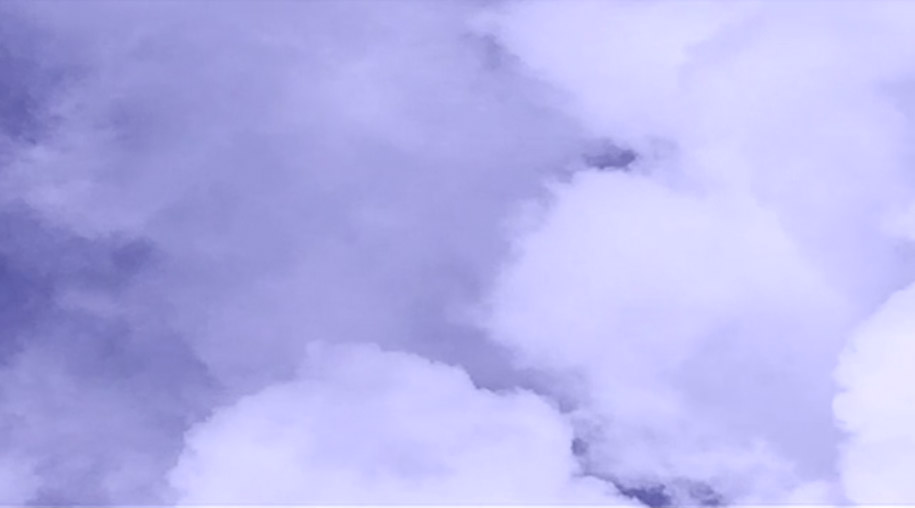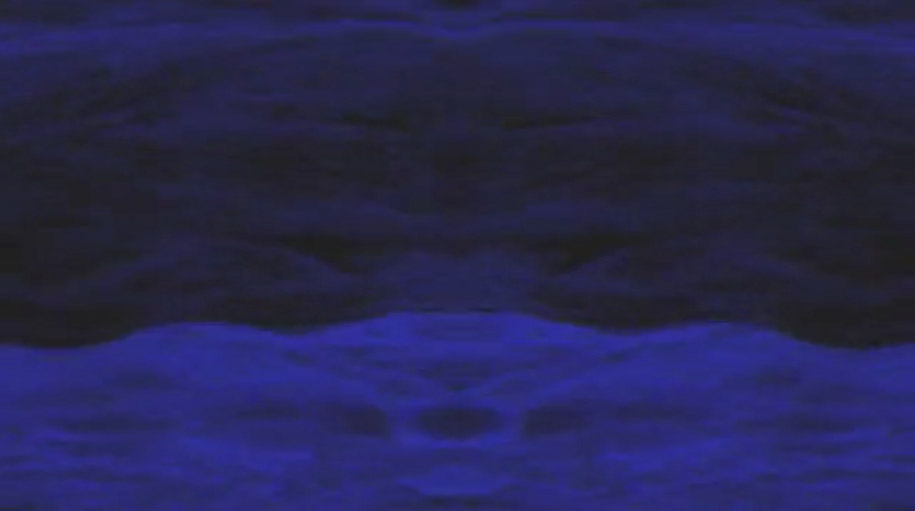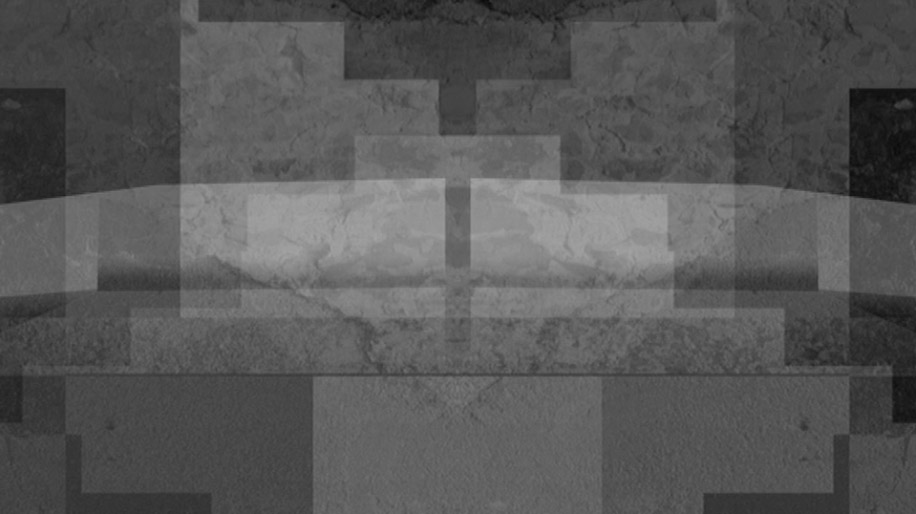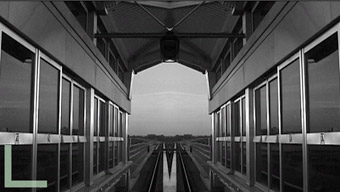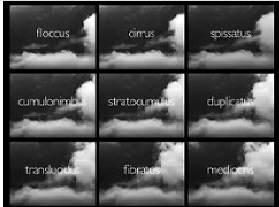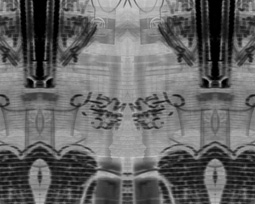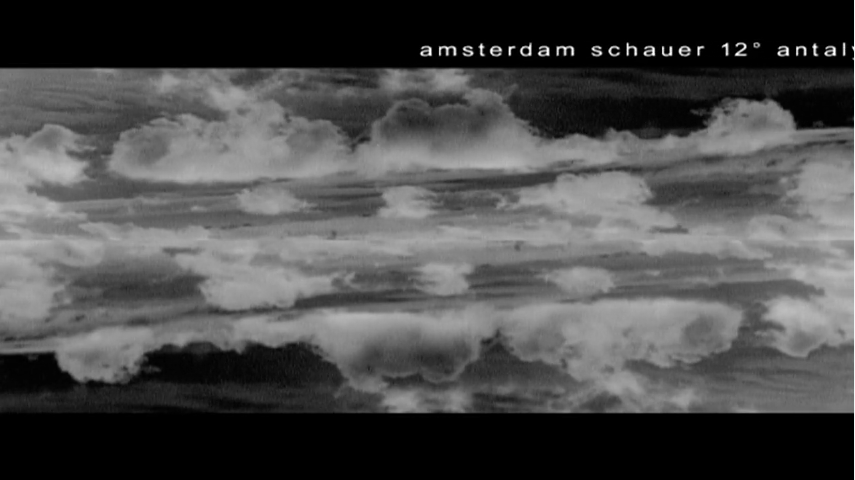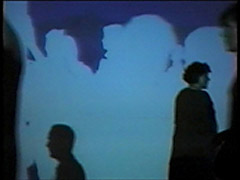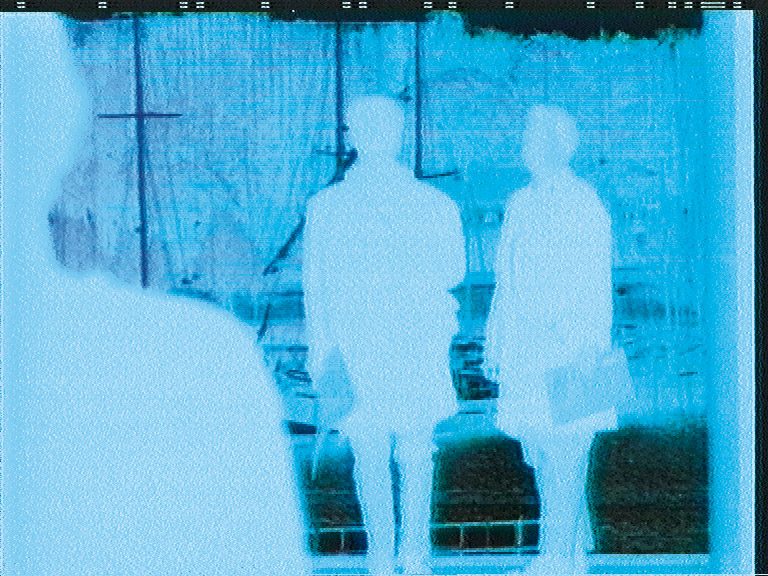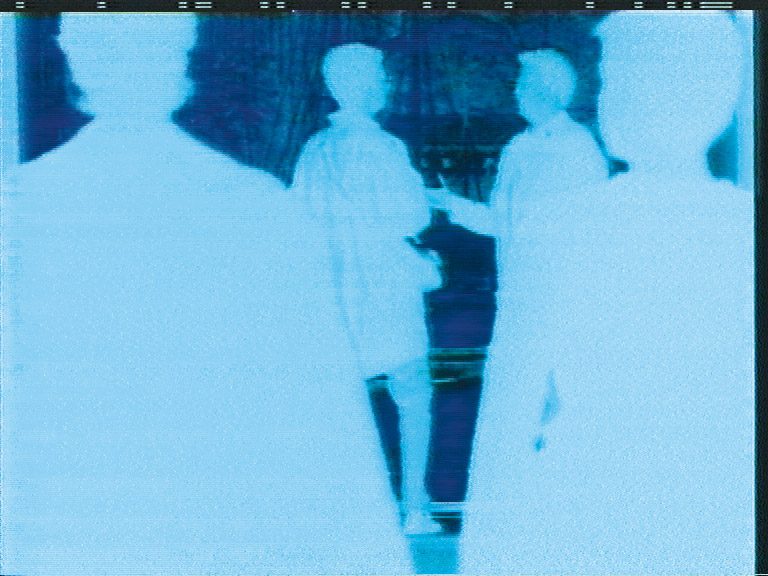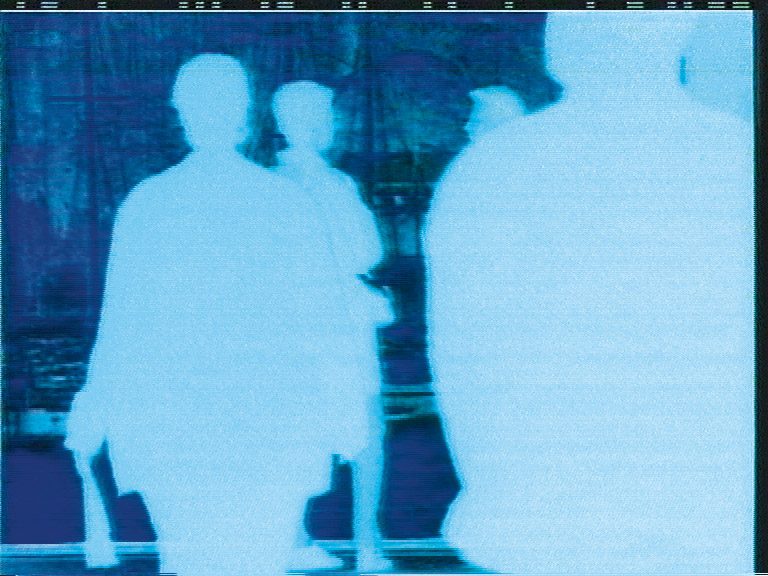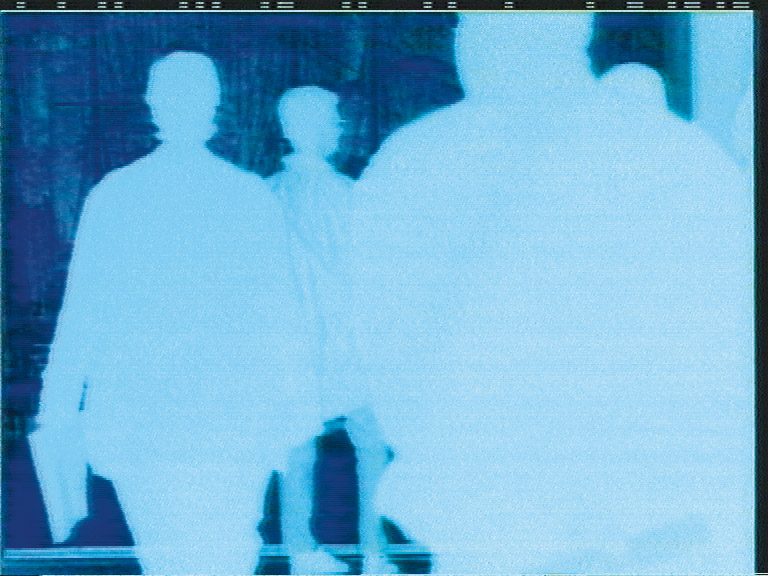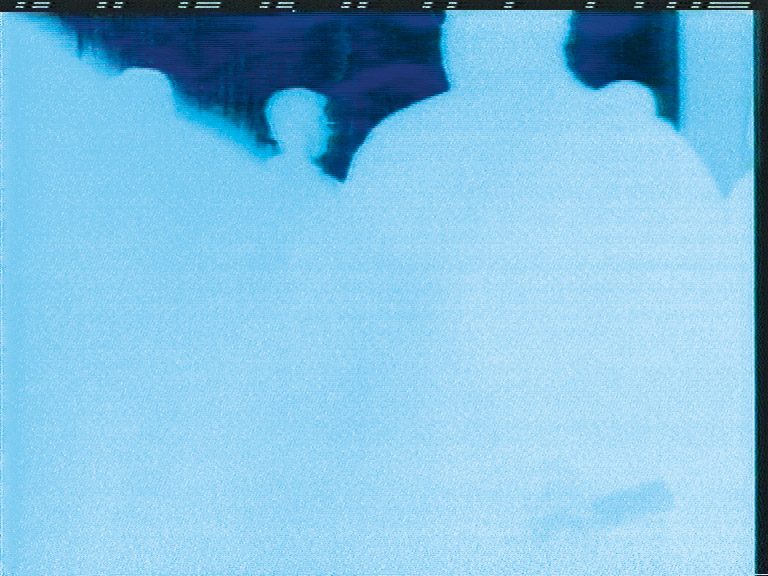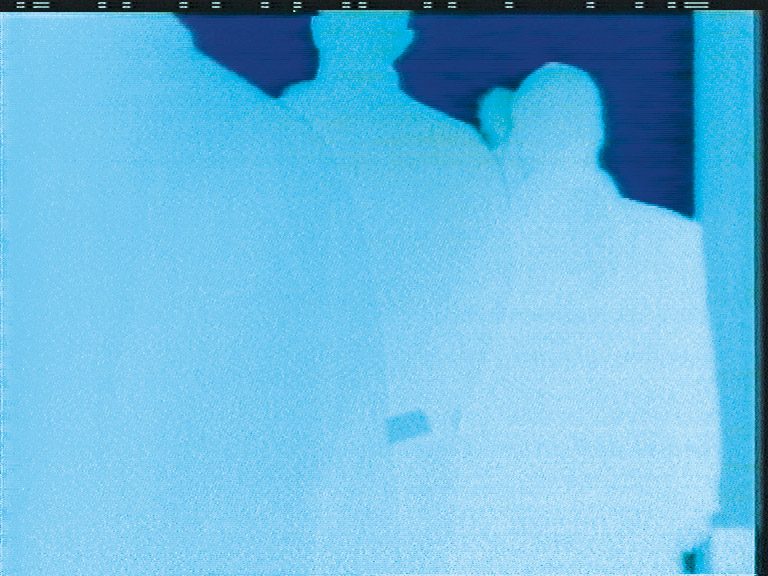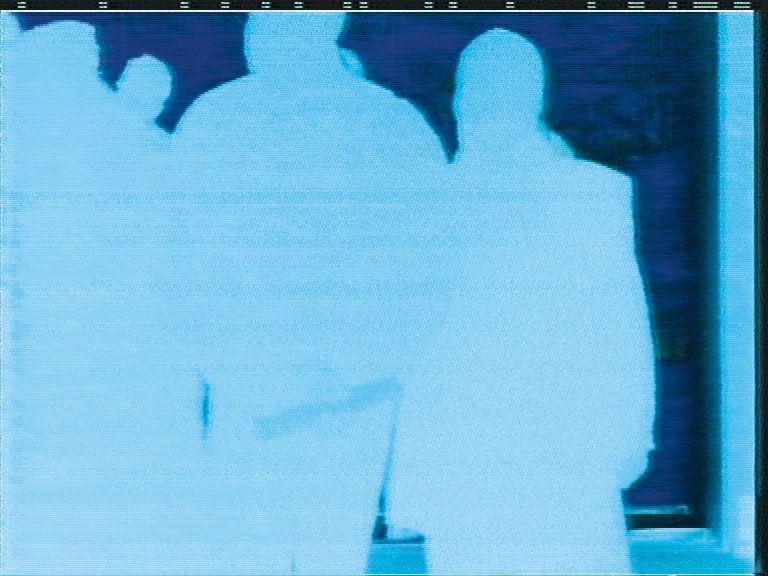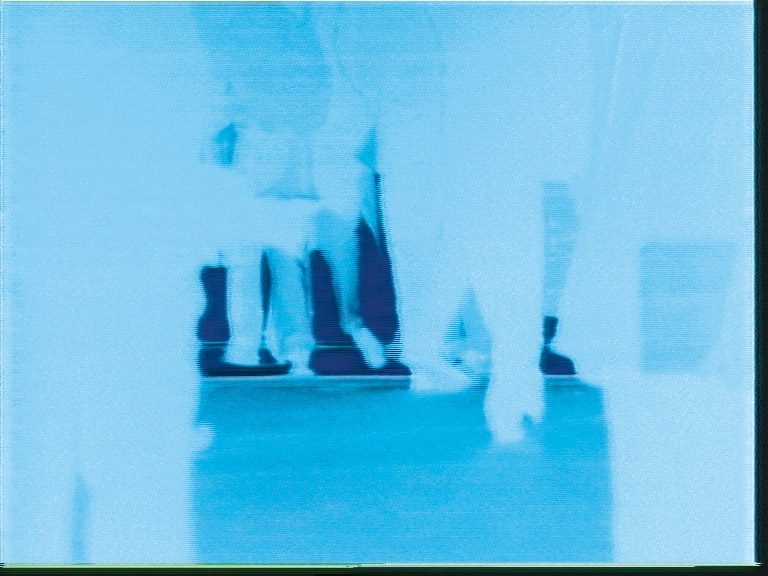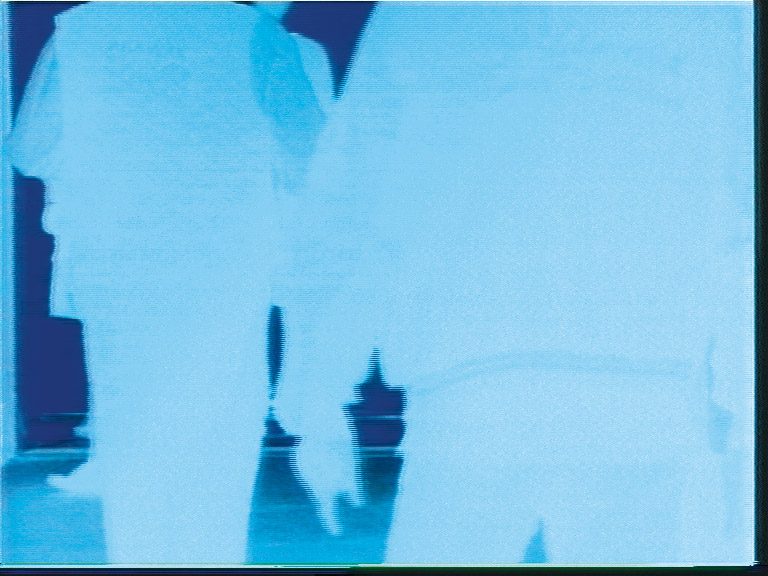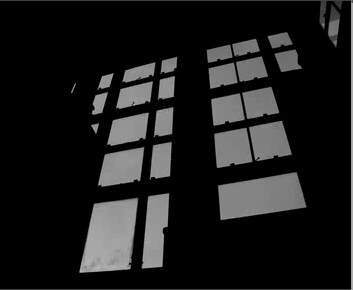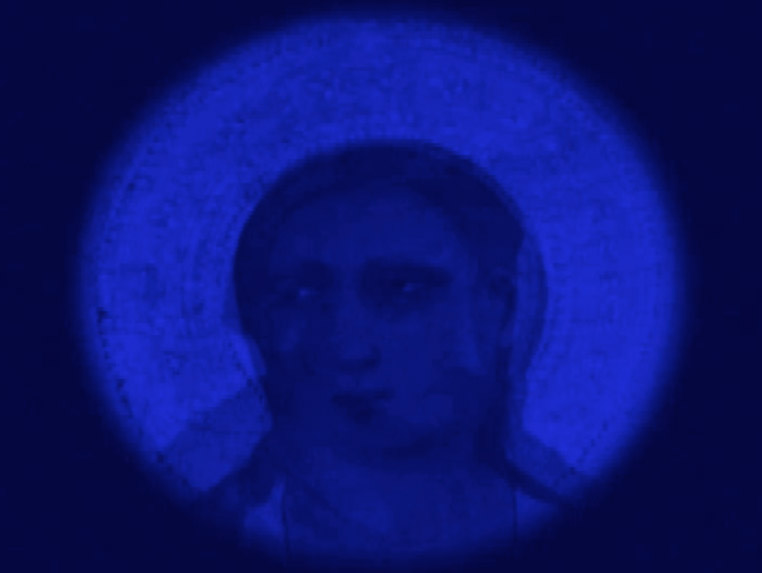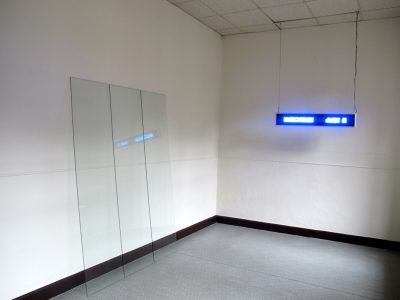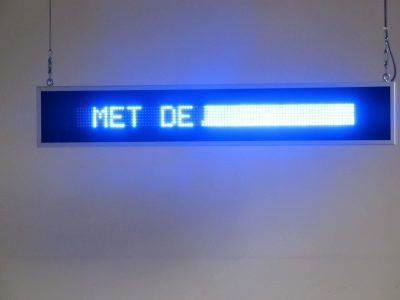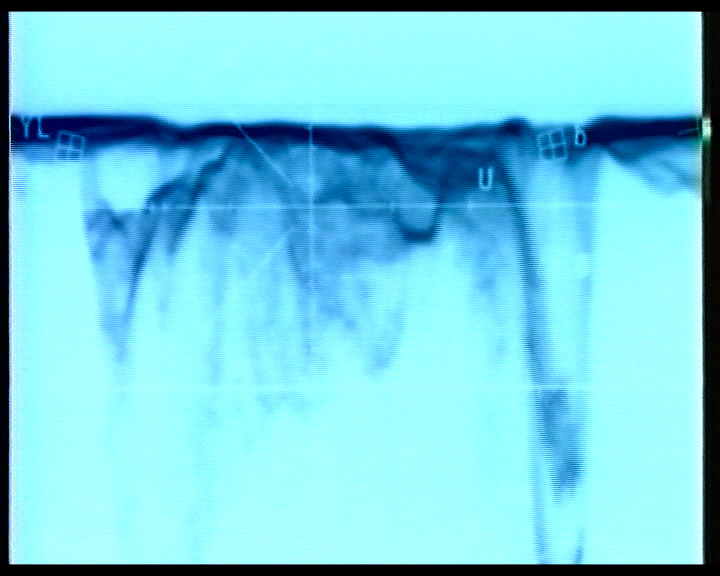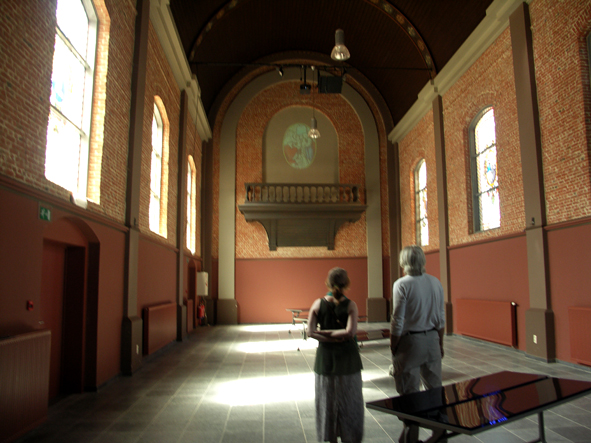videos
2022 | Pavilion
PAVILION
B/W video (installation) – 11’24 – mute
“For her intervention in INBOX of the M HKA, Thomaes took an existing building as a starting point, namely the Belgian pavilion in the Venetian Giardini, designed by Léon Sneyers and renovated in the 90s by Georges Baines. Thomaes has long been fascinated by the modernist building, particularly by its symmetry, minimalist design and magisterial zenithal light. A cardboard scale model has been in her studio for some time now and serves as a zone of exploration. The images projected onto the walls of INBOX are digitally and analogously realised in the model. By projecting these black-and-white images in careful timing into this white cube space, the artist brings a stylised interpretation of the pavilion and its specific light conditions. The result is not an architectural experience but its sublimation into an aesthetic and poetic choreography. Architecture is here literally and figuratively abstracted into its visual essence, a geometric play of planes, horizontals and verticals, light and shadow. Like a melancholy ode to a lost modernism. The visitor inevitably casts shadows on the projections, so that the purified images are temporarily distorted and inhabited by the silhouettes of the viewers.”
Johan Pas,
Director Academy of fine Arts,
Antwerp june 2022
2020 | bredaphoto
proposal bredaphoto 2020
the glory / the violence of the sea
Bredaphoto 2020 – the worst of times / the best of times
A PROPOSAL
the glory of the sea / the violence of the sea
the noiselessness of silence, the splendour of light, the passing time
flux reflux
observation needs time and space
photography
series of photographs, several dimensions
mounted in a dark room with reflecting floor
videoprojection
the meditative character of the photographs is converted into image
and sound projection in a dark room with reflecting floor
the public walks through the projection and becomes part of the work
1997 | hombre
hombre
1997, 2 parts, 2’, 4’, colour, sound, dv
première: Intime Expeditionen – Badischer Kunstverein Karlsruhe 2001,
Haus-am-Waldsee Berlin 2001
video installation
Whereas in previous works static and slow-motion-effects are used, this work was the start of a new serie of image manipulation by using video-technical possibilities. a man is filmed on the cathedral place in Granada. He prepares himself for the procession. The colors are manipulated into over-exposure, his movements shortened and repeated, the rhythm decided. His motion is manipulated into a short piece of dance, of performance, showing himself. The place, the time of the day are not shown.
2018 | minimal_series_ #05
_light_spaces_ #05
_light_spaces_ #05
based on architectonic plans
2018 | minimal_series_ #04
_light_spaces_ #04
_light_spaces_ #04
based on architectonic plans
2006 | breathtaking
breathtaking
2006, different parts, b/w dv
première: “breathtaking” 2007, Fstforward gallery, Antwerp
Video recordings of the Manhattan skyline are the starting point for this work. Hundreds of stills of this raw material are manipulated and converted into independant elements. These elements are grouped as new structures reminding to scores and choreograhpy. Time and movement are predominant: the existing architecture and its environment are subordinated to the movement, time is stretched out, tension is built up.
All these elements are flowing together into a breath-taking experience.
Breathtaking
Twintig jaar heeft ze in Nederland gewoond en gewerkt, en ruim tien jaar in Berlijn: sinds 2002 verdeelt de belgische kunstenares Monique Thomaes haar tijd tussen Antwerpen en Berlijn. Thomaes maakte vroeger installaties, sculpturen en integraties met glas, metaal en hout, waarbij licht, tijd en ruimte een grote rol speelden. De Berlinische Galerie kocht werk van haar en dank zij een werkbeurs van de Berlijnse Senaat kon ze een overzichtscatalogus (de Passage) maken van tien jaar werk, tot en met 1997. Ook in Berlijn ontstonden de eerste videowerken, waarmee Thomaes nu opgang maakt. Ursula Prinz (Berlinische Galerie) daarover in de catalogus: “De kunstwereld van Monique Thomaes ligt in het immateriele. Haar werktuigen zijn de camera, de videocamera en de spiegel. Met behulp daarvan legt ze haar sujet vast: het licht. Want de vluchtige schaduw, de weerschijn die met verloop van tijd verandert of de tijd die zich manifesteert in het wisselen van het licht, zijn het fragiele medium van deze kunstenaar.” Die nu tien jaar oude tekst slaat wonderwel op het recente videowerk dat Thomaes toont in het Antwerpse fstforward. “Breath-Taking” uit 2006 bestaat uit foto- en video-opnames vanaf de Empire State Building van Manhattan. Ze maakte er twee werken mee: een waarmee ze aan de hand van honderden opeenvolgende foto-stills de skyline van (een stuk van) Manhattan heel langzaam laat evolueren in tijd (en dus licht); en één waar videogewijs heel langzaam wordt ingezoomd op enkele buildings. In elk van de werken gebruikt Thomaes meerdere stroken naast elkaar die elkaar spiegelen, zodat je het effect krijgt van een Rorschachtest, met beelden die van en naar het midden uit- en invloeien. De fstforward-ruimte werd binnenin uitgerust met spiegels, wat het effect van spelen met ruimte, beweging en tijd nog versterkt. Bovendien kan men door het zijraam van binnen naar buiten kijken zodat het Antwerpse stadsleven (met weliswaar minder “sky-effect”) in het Manhattan-droomwereldje binnensluipt. kortom, een poetisch-meditatieve ervaring.
video
video
2000 | blue motion
blue motion
2000, 30’, colour, dv
première: video projection OEB, Berlin 2001
A succession of moving images designed in the analogue videotechnic and resulting in a meditative submersion in space and colour in a fluid rhythm.
Installation
In the staircase hall of the building I projected the videowork on a big screen placed in front of the entrance and the street: inside the silence, outside the streetnoise (passengers, cars, trains) and played them off against each other.
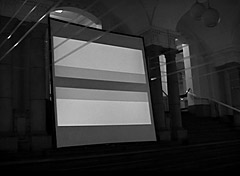
2000 | (e)space(s)
(e)space(s)
2000, 2 parts, each 10’, b/w, dv
première: Schloss Plüschow, Mecklenburgh, Germany 2002
video installation
Two opposite windows filmed without changing the light circumstances, each window, changing the diaphragm minute after minute. The films show the two windows progressively from the deepest darkness into disappearing in total brightness.
1999 | midi
midi
1999, 5’, sound, b/w, dv
People in a sunny situation, filmed with over-exposure. The film is manipulated by cutting and repeating their movements. People are knowable, but changed into actors. The situation, the place, the action are not known. Image and sound are defining the rhythm.
1998 | still / search / still
still / search / still
1998, 2 parts, each 13’, b/w, dv
The subject is a guard, turning his face from left to right in one minute. In the video the movement is stretched out by using slow-motion; the face is cut into parts; the slowly moving image tries to rejoin this parts.
1998 | k.b. 1800 sec
k.b. 1800 sec
DV, colour, 1800 sec
shooting location: Künstlerhaus Bethanien Berlin 1998
A static 30-minutes video recording through a window of the Künstlerhaus Bethanien observing the square.
The date and the time are recorded. The basic material is cut into 1800 stills; in the process of editing, every second, the stills are successively shifted, changing their colours at the same time.
Time and place are visible.
1998 | femmes / messages / femmes
femmes / messages / femmes
1998-2008, 3 parts, each 3’, colour, dv
première: Künstlerhaus Bethanien, Berlin 1999
other presentations: CC Mechelen 2006 (italian version)
Part of a work based on the photography of a plaster sculpture, a women, which was shot in Florence’s Galleria dell’Accademia. It was the basic material for a lot of photographic works and a slide-projection installation. To this diversity of images a play of French adjectives is added. Alphabetically ordened and rhythmically edited, they created images in the head, which changes by each adjective.
(3 versions: french, italian, spanish)
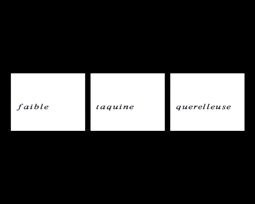
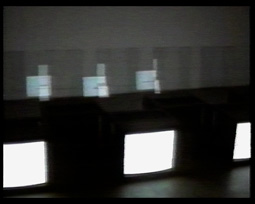
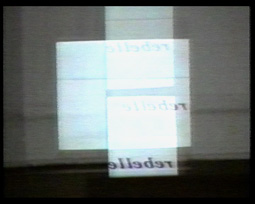
installation view Bethanien 1999
1998 | piétons
piétons
1998, 5’, colour, sound, dv
This work is based on the same material and the same
principle as the work point de vue
1997 | flux
flux
1997, 4’, colour, sound, dv
De ongezochte Vondst, Odapark Venray, Netherlands
video installation
Out of the series observations (people, clouds, water, wind, time, light)
An observation of water in close-up, edited as an explosion.
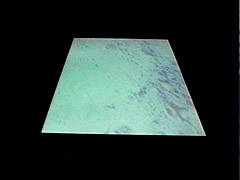
1997 | couchée
couchée
1997, 7’, colour, sound, dv
Angelika Stepken about the work
“The first images are almost without information for the spectator. With the first movement of the image one can discover a closed eye, filmed from the side. A tender, intimate close-up. The movement of the picture is strangely discontinuous. The (original) sound track is doubling this sensation. No place, no time is indicated.”
1996 | o.t.
o.t.
1996, 15’, sound, colour, dv
Using and misusing the characteristics of technical equipment is the basic intention of this work. The rhythm of moving slide projectors and their acoustic signals shown on a oscilloscopic display are filmed: a combination of image and sound which results in a strong cadans.
1996 | white (e)space(s)
white (e)space(s)
1996, 30’, b/w, dv
Different experiments with slide projections. By filming, doubling and editing the material several light videos are created.
1995 | v-ivre
v-ivre
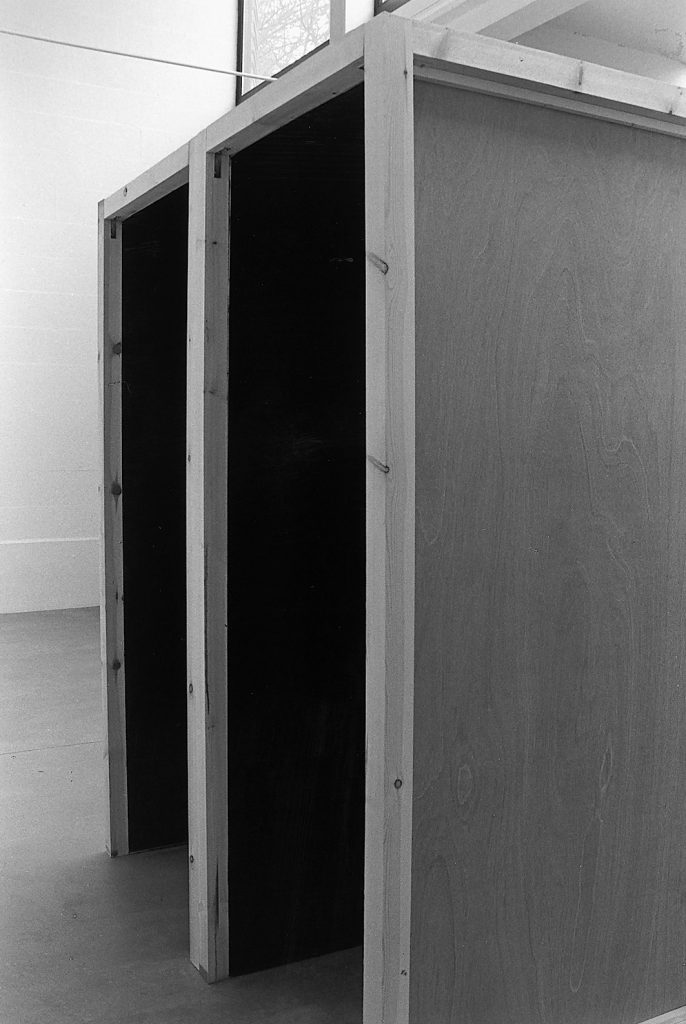
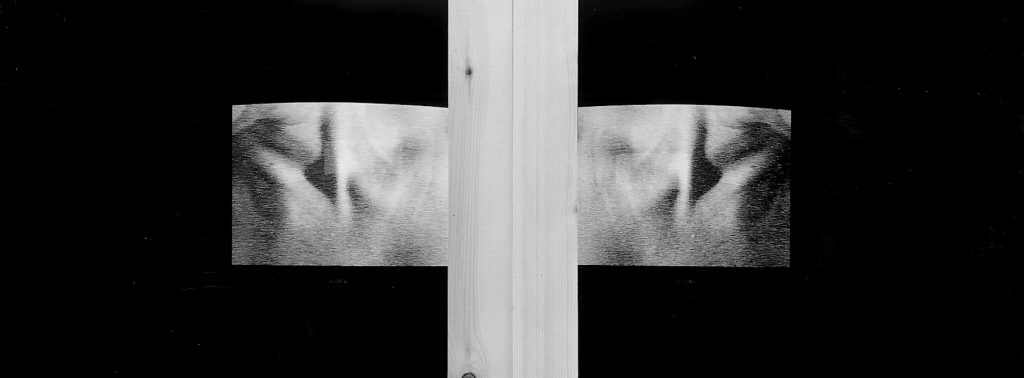
1995, 2 parts, each 10’, b/w, dv
Galerie Bostoen, Kortrijk, Belgium 1996
Multimedia
Luk Lambrecht about the work
“The two ascetic videotapes show a ten minute sequence depicting inhalation and exhalation, taking place around the neck area of the artist.
The slowly moving, black and white self-portraits are, at first glance, not recognizable as such, but instead show a great similarity with abstract, three-dimensional texture. The video images are played back with a coarse grain; thereby results an aura of fundamental unfamiliarity and doubting concerning that which is perceived. Owing to effects of close-up’s, the pictures take on an incorporeal aspect and within the context of an art exhibition may be interpreted as gently rising, almost draped pictorial representations. They are forceful pictures because the observer is simultaneously aware of both video images; consequently life’s rhythm becomes distinctly conscious, an effect which is further emphasized by the occasional insertion of still-video pictures which thereby gives rise to short pauses during the run of the video.”
1995 | plaatsen / lieux / spaces part #01
plaatsen / lieux / spaces part #01
lieux
1995, 3 parts, each 8’, b/w, dv
Première: CCNOA Brussels 2007
shooting place: Salzburg/Hallein 1995
A camera is statically pointed toward a large room. Gradually and successively the camera’s aperture is opened. Initially, the picture in the monitor reveals merely a narrow slit of light located at the lower edge, in appearance somewhat similar to a drawing placed upon a dark background. Slowly but surely the line fills out to a re-cognizable room volume, until ultimately in a glistening white this figure loses both its dimensions and contours and is reduced to an empty surface. An opening and a closing-up of the room/image to vision, a gentle process.
(Angelika Stepken in the book “the passage – monique thomaes” 1998)
A comment of Christoph Tannert in the catalogue “de passage”: What patience such a room needs!
1995 | salzburg sonnig
salzburg sonnig 28 grad
1995, 9’, b/w, dv
première: Salzburg, Hallein 1995
Observations of light and time: observing the gliding clouds from a defined point in a given space.
1995 | blau-äugig
blauäugig
1994/95, 2 parts, each 15’ colour, dv
première: CC Scharpoord Knokke, Belgium 1995
Multimedia
Antique sculptures photographed in Berlin’s Pergamon museum. These photos became the „raw material” for various media combinations: a photographic installation, as well as a slide projection and a video work.
blau-äugig
… back/repeat: The possibility that the human figure could enter in Thomaes’ work was never excluded. This role was always filled by the observer of her work who, in a 1:1 ratio, could find himself reflected in the sculptures and installations. In the works dealing with room space as well, it is the visitor’s living, moving body which produces reflections or silhouettes in the light. On the level of image creation, it is in the first place the photography of sculpture that offers a primary, static – and twice reproduced, therefore mediated – picture of the human being. In Berlin’s Pergamon museum Monique Thomaes photographed antique sculptures. These photos became – as is characteristic for her method of procedure – the “raw materials” for various media defamiliarizations and combinations. For the installation “Blauäugig” (1995), she transformed her initial working material into photographic details, actual reflections as well as video films and slide projections. From these documents of anonymous sculptures, she deleted the eyes and the area about them – a motive similar to that used later in the video “Couchée”. Thus the eyes of the stony figures are blank; they do not offer an observant glance, but rather its omission. The eyes of the photograph are shadowed zones. In the center of the picture is, nevertheless, the distance between the eyes, that point between the eyebrows which leads to the forehead and which, in the condition of tension-filled concentra-tion, forms into wrinkles. It is that imaginary point where an exchange of the senses between interior and exterior, between vision and cognition, becomes focused, and where projections from interior and exterior images intersect. This point gives hardly anything away visually and it is considerably less attractive than the eyes; for one intuitively searches for eye contact with one’s peer even if that peer is a centuries-old sculpture in photographic reproduction. First comes an intimate jolt caused by confrontation with the set-back eye cavities and absent eye contact of the sculpture which thereby forces one’s glance to wander to the forehead, a surface formed by light and thereby giving it only a small degree of depth. Like a blind mirror this image throws back the observer’s intruding stare, tossing it back behind his forehead. Vision meets the visionless. A short-circuit, a silent implosion. The body as a sculpted, objective given have sought refuge in the work of Monique Thomaes. It has retreated back to the level of its representation, the image, and has revealed itself as a doubtful witness of its very self. Doubts are existentially connected with symbolization. The possibilities of manipulation offered by the procedures in technical image making, allow Thomaes, on the most diversified levels of visual presentation, to manifest these doubts (both self and media reflexive) in a visual form.
2001 | shift / colour / shift
shift / colour / shift
2001, 2 parts, each 8’, colour, dv
video installation
Haus am Waldsee Berlin 2002
Computer designed single colour planes which are arranged according to a specific mathematical pattern based on the RGB mode are at the outset of this experimental study. The individual images appear in certain different sequences and rhythms. The work found his inspiration in the work Piano Phase (Steve Reich 1967) and could be accompagned by this music in an installation.
installation view
2003 | icon
icon
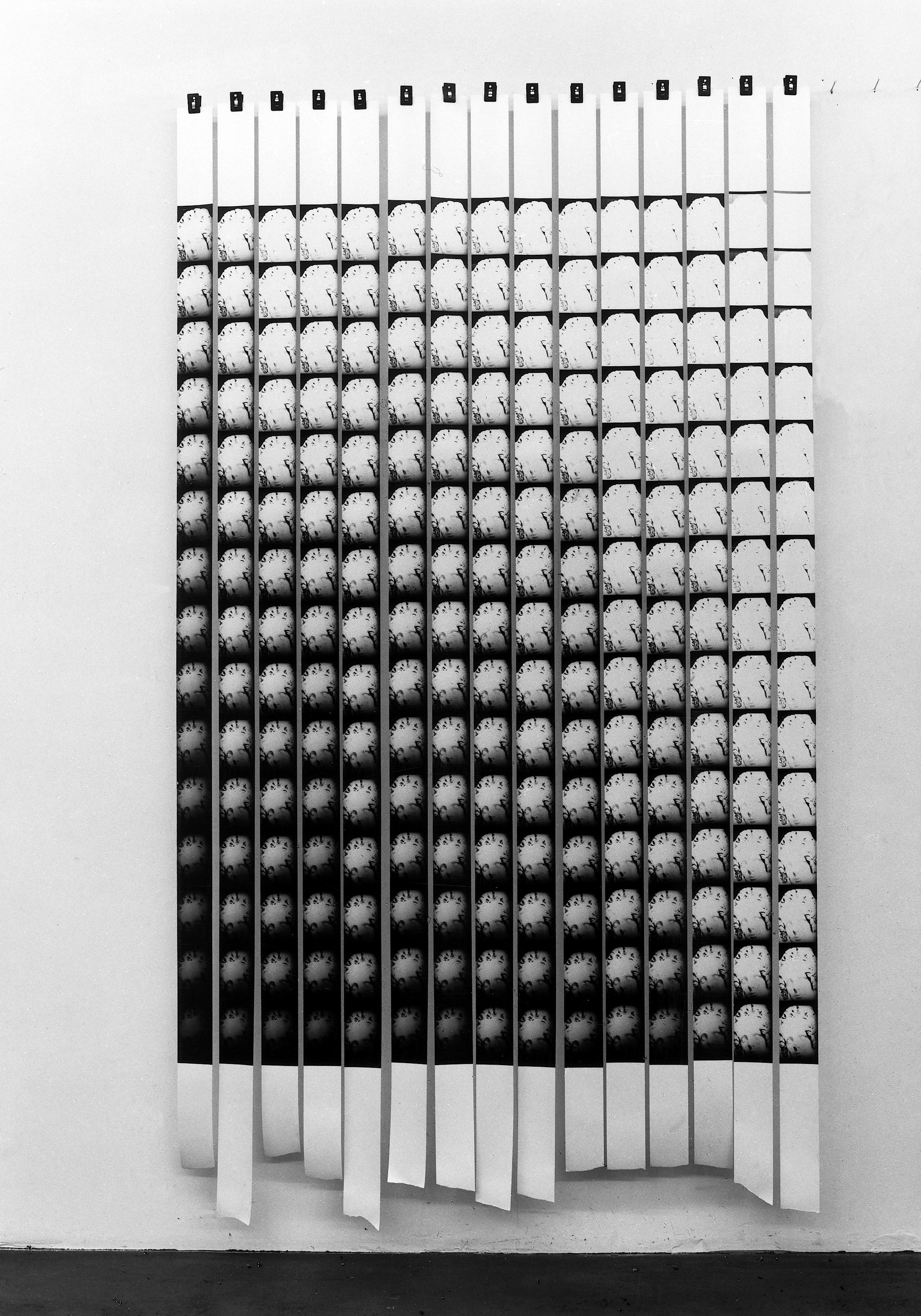
2003/2006, 12’, colour, dv
installation: projection (image) and
led-display (words)
A plaster sculpture stood “Model” for this work. The photograph has been manipulated. The videowork is developped out of one of these photographs: one-second-images are showing in 6 minutes the face of the woman that is disappearing the next 6 minutes.
To this diversity of images the play of French adjectives is added. Alphabetically ordened and rhythmically edited, they created images in the head, which changes by each adjective.
see also the video work femmes/messages
2003 | tree movements
tree movements
2003, 5:26:24, colour, dv
Out of the series observations (people, clouds, water, wind, time, light):
instanteneous photograph of a poetic (shadow) image.
The “still” is moved out of his dreamposition with a certain interval and put back in his starting position after 5:26:24.
2004 | gestes / gesten
gestes / gesten
2004, 2 parts, each 5’30, colour, dv
première: Video Festival Rencontres Internationales Paris/Berlin 2004
2nd presentation: exhibition Stippels en Pixels, Zebrastraat Gent 2005
work in progress
TV-images from the daily international news out of the period of 11.9.01 observed and noted down the images: analysed, isolated
the material: manipulated, alienated, accentuated and assembled in a succession of a hundred of stills suggesting an innocent causerie.
place, time, theme become universal
A text by Vilém Flusser is cited: this is not meant as a subtitling but the words are moving the images to an higher plane of imagination.
2004 | ochos
ochos
2004, 4’, sound, colour, dv
première: video projection Maaltecastle Gent 2005
other presentations: screening Arenbergschouwburg Antwerp, Belgium 2006
video projection
Fascination for the choreography and work of Pina Bausch is the starting point for this video work. The movement of the dancers has been observed and analysed, the physical environment extended to an architectural experience and the music reduced to a sound decor.
time / movement and counter-movement / dramastructure / silence / speed / passion / tension / superiority / balance /
constitue the vocabulary of the final result; they conduct to architectural images with an emotional and sensual tension.
2007 | andante
andante
2007 6’40 colour dv
première: video/multimedia days Antwerp, Belgium 2007
video installation
other presentations: “passie voor het ongrijpbare” St. Truiden, Museum Vlaamse Minderbroeders, Belgium 2007
The videowork “andante” is meant as an hommage to the filmmaker Ingmar Bergman.
The fascination for the monumentality of the images has resulted in different essays. Some details were taken out of the films, manipulated and assembled to a new composition where the movement and the repeating of the quiet action is creating a new visual experience.
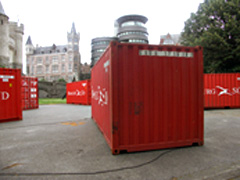
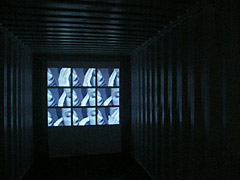
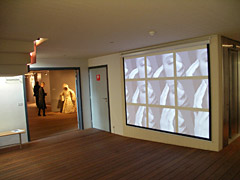
2008 | plaatsen / lieux / spaces
plaatsen / lieux / spaces
part #01, 3′, b/w
part #02, 3′, b/w
part #03, 3′, b/w
2017 | memories_series_ #04
_breathing_space_colour #04
_breathing_space_colour #04 – 3’
following the landscape beneath out of a plane
2017 | minimal_series_ #03
_inter_scapes_ #03
_inter_scapes_ #03
b/w – 2’08
animation of computer made objects
2017 | minimal_series_ #01
_light_scapes_ #01
_light_scapes_ #01
b/w – 3’
starting from a hundred of shootings out of a moving vehicule
transformed to moving and lightening spaces
2017 | minimal_series_ #02
_moved_architecture_ #02
_moved_architecture_ #02
b/w – 4’40 different experiments
playing with the possibilities and tools of google
2017 | memories_series_ #01
_passages_colour_ #01
_passages_colour_ #01 – 1’50
following the clouds by a security camera
2017 | memories_series_ #03
_traces_ #03
_traces_ #03
b/w – 3’10
observations of light and time
2017 | memories_series_ #02
_water_blues_ #02
_water_blues_ #02
colour – 2’50
observations of the sea in a dynamic choreography
2008 | suite
suite
2008
suite, 3′, b/w
The work is meant as an hommage to Alfred Stieglitz.
Recordings and photograps from clouds taken in Italy in 2008 are the basic material.
The flow of words is based on The Cloudspotter’s Guide – Gavin Pretor-Pinney.
2005 | sea_light_see
sea_light_see
2005, 6’15, b/w, dv
picture: belgian northsea 2005
text: weather report tagesspiegel berlin 1995
première: double video projection in the exhibition Hot-Re-Strike – Warande Turnhout, Belgium 2005
“sea_light_see points our eyes to the heavens, although the title awakens more associations to the sea. The phenomenon of bioluminescence – the illumination of the sea through millions of single-celled algae – shows a very strong relationship to the atmospheric play of lights in the atmosphere over our heads. The sun, the most important heavenly body, is our natural source of ultraviolet radiation. The large part of the radiation invisible to the human eye is absorbed by the earth’s atmosphere. It appears that the heavens can be grasped only in the veiling play of clouds”.
(Text on the exhibition by Stef Van Bellingen – Curator)
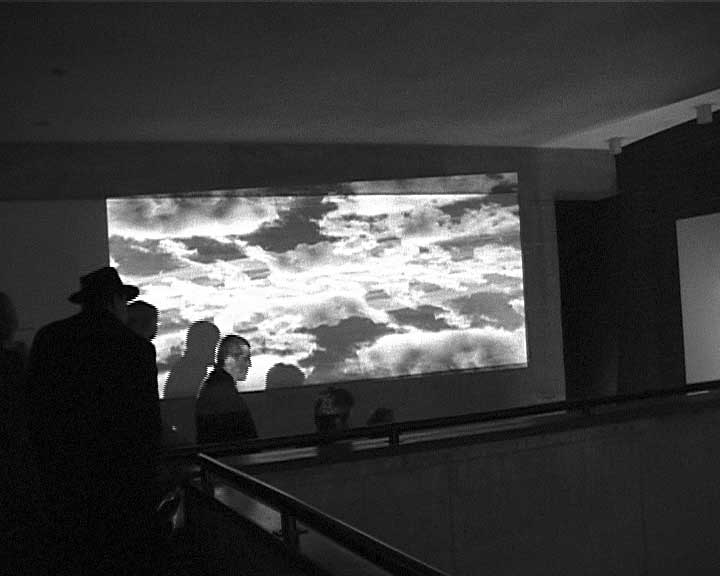
1997 | point de vue
point de vue
1997, 10’50, colour, sound, dv
première: video projection Argos, Brussel, Belgium and NBK Berlin 1998
other presentations: Belgian Embassy Berlin 1998
shooting place: the Moderna Museet Stockholm during the open days before the opening of the museum
Groups of people are moving in different directions, a voice is giving some informations. The filmmaterial is manipulated: the bodies are disappearing in over-exposure, their movements are dissected into several short and long sequences. The room is not identifiable, one could speculate that they has assembled here for some specific occasion. The cuts are visible: the rhythm is given by the combination of image and sound.
– augen blenden – 1998
published in “de passage monique thomaes” vice versa verlag berlin 1998
translation by John Epstein
point de vue
… forward: The figures appear like white shades of themselves, sections left blank, a negative. Groups of figures move in different directions, advancing toward or away from one another. The room is not identifiable; one could speak of the interior of a room with a window front and then go on to speculate that a group of people has assembled here for some specific occasion. So much for the initial situation, the givens. The situation in the film is another: bodies are deleted out to light contours. Their series of movements are dissected into several long image sequences which are played back in either direction, forward and backward. The cuts represent caesuras in time and, as such, are visible. Movement in space mutates to technical movement in time. There is the time span of the video-tape (ten minutes), and there is the discontinuous time created by the broken, jagged movements which, freed from progression in actual space, drive to insanity since these images no longer spring from technical necessity but rather from pure, technically feasible, imagination. Cold, frozen time assembled piece by piece. The figures of the negative freeze in reproduction, then dissolve in fuzziness. The white shadows liquefy to a fall-out of light …
… back: In the Pergamon Museum Monique Thomaes observes how window and curtains, even the passing of the elevated train, are reflected in the glass of the exhibition display cases. Hence to her the display cases themselves appear to be ideal sculptures, transparent bodies, in that they simultaneously reveal the extensiveness of space, the outer space external to them, and even that true exterior space which is reflected via the glass pains of the window. The object undergoes a multiplication and a synchronism of appearance, the selective cognition and focalization of which are left up to the observer.
point de vue
The first photograph in history was created by the Frenchman, Nicéphore Nièpce, in the year 1827. It was entitled “Point de Vue” and it depicted a view from the window of the photographer’s study. Monique Thomaes’ most recent video work bears this same title, one which is fraught with numerous significant meanings: first of all it means “view” or “vista”, a meaning which in principle the photograph by Nièpce also includes and which encompasses the connotations of perspective, expectation, possibility, and hope; however there is another meaning to this expression which predominates above all the others and which may be translated by “point of view”, a word carrying with it the abstract connotations of viewpoint, aspect, and angle of observation. Upon closer consideration of Monique Thomaes’ works, all these aspects and levels of meaning gain both validity and relevance. The short, repetitive sequences of the video work “Point de Vue” seem like early animated photographs; the work is visually related to such predecessors both in its color scheme as well as its lack of focus. In much the same way that the first photographic attempts using the camera obscura and asphalt coated glass plates did not allow for sharpness of definition, so within the boundaries of the monitor, do the videotape’s electronic images disintegrate into vibrating “points”.
In his book “The Basic Principals of Art History”, art historian Heinrich Woelfflin observed that throughout the history of painting and drawing the dominance of line continuously diminished; it was in this phenomenon that he maintained he was able to observe the esthetic expression of a society’s successive inner, agitated states. It is in this manner that video and computer pictures, in which there are no longer lines but rather (pixels-)points, can be seen as the provisory point of termination in this line of development. Moreover, the “nervousness” of these constantly moving and striking images serves as an appropriate symbol for the frenzied rush of our time and for the outer and inner circumstance of our culture.
However, there are other reasons why Thomaes utilizes the artistic medium of video as an instrument for presenting her ideas. One overriding reason can be summed up with a sentence written by Annelie Pohlen in her article for the catalogue “Videonale 6”: “It is above all the immaterial, the illusive, that thing which cannot be defined according to temporality, location, or spatiality, or the conceptual malleable reflection concerning, yet resisting, reality, which the technical Instrumentarium video – owing also to its connection with the flow of light energy – essentially boosts. The artist herself has indicated the above with her comment: “In this form I have attempted to reach a certain immaterialness in my themes, to allow them to become fleeting.”
Monique Thomaes emphasized the important role of “light energy” (in other words light as a formative element in her work) in another context. This question of the “form of light” – in its scientific as well as philosophical dimension – was already first broached and discussed in detailed in the 13th century essay “Forma Lucis” by the Italian theologian and philosopher Bonaventura. Light as a concrete epistemological, theoretical, abstract-religious concept has, over the centuries, repeatedly played an important role in art history – among others in the history of the painting of Flanders, the artist’s homeland.
During the years Monique Thomaes has spent in Berlin, light’s representational possibilities and the processes of perception which it requires have always played an important role in her work. Thus in view of this continuing occupation with the theme of light, one may add these diverging strands in the interpretation of “Point de Vue”: “view” as the light of hope, and “point of view” as something throwing light upon an object, thereby allowing it to appear in a new light.
Light projections, time-light photographs, light reflections, and notes concerning light reflections were stations along the way to “Point de Vue”, a work which contains light flooded images of people appearing as though they have come from the heliotypic processes used by Nièpce. The corporeality of these figures seems to have been taken away; they express an atmosphere of brevity and transitoriness, this indeed being one of Monique Thomaes’ recurring themes.
During the shooting of their film concerning the first photograph of the world, which, as has been mentioned above, was entitled “Point de Vue – the view out the window”, Swiss film directors Bernhard Lehner and Andres Pfäffli were confronted with this “photo incunabulum” at the University of Texas in Austin, where it is kept. To their astonishment, they noticed that during observation of the almost invisible picture within the glass display case, outside of their own reflection there was almost nothing else to be seen.
The comment arising from this incident: “seeing and knowing – that which we don’t see is perhaps one of the secrets in image creation.” This statement could also stand as the motto for Monique Thomaes’ video creation “Point de Vue”.
2012 | art_silence
ART(silence)
participation internet-project 2012
University Ghent
ART(silence)
24”
ruimte_licht_tijd _beweging_
minimale verschuivingen
in lichtintensiteit
verlokkend
kwetsbaar
een intense ervaring
een veelgelaagd proces
van licht
naar donker
naar licht
in stilte
inademen
uitademen
adem_tocht
mt 2012
1999 | a cappella
a cappella
1999, 8’40, colour, sound, dv
première: Rencontres Internationales Paris-Berlin, video projection on a window in the streets of Paris 2003
and video projection in the hall at Podewil, Berlin 2003
A group of talking children filmed in a museums’ hall. The images and the sound are manipulated into a rhythmical dance and then reduced to the acoustic signals shown on the oscilloscopic display.
Distribution contact: info@art-action.org
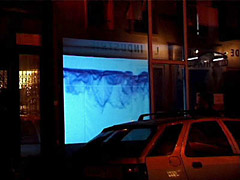
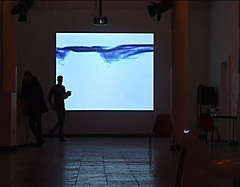
2010 | move_d
move_d
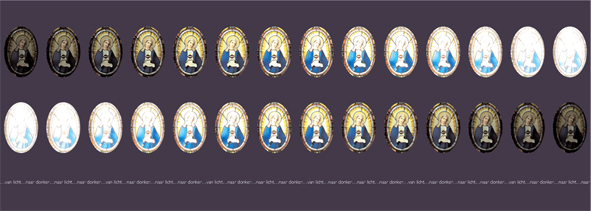
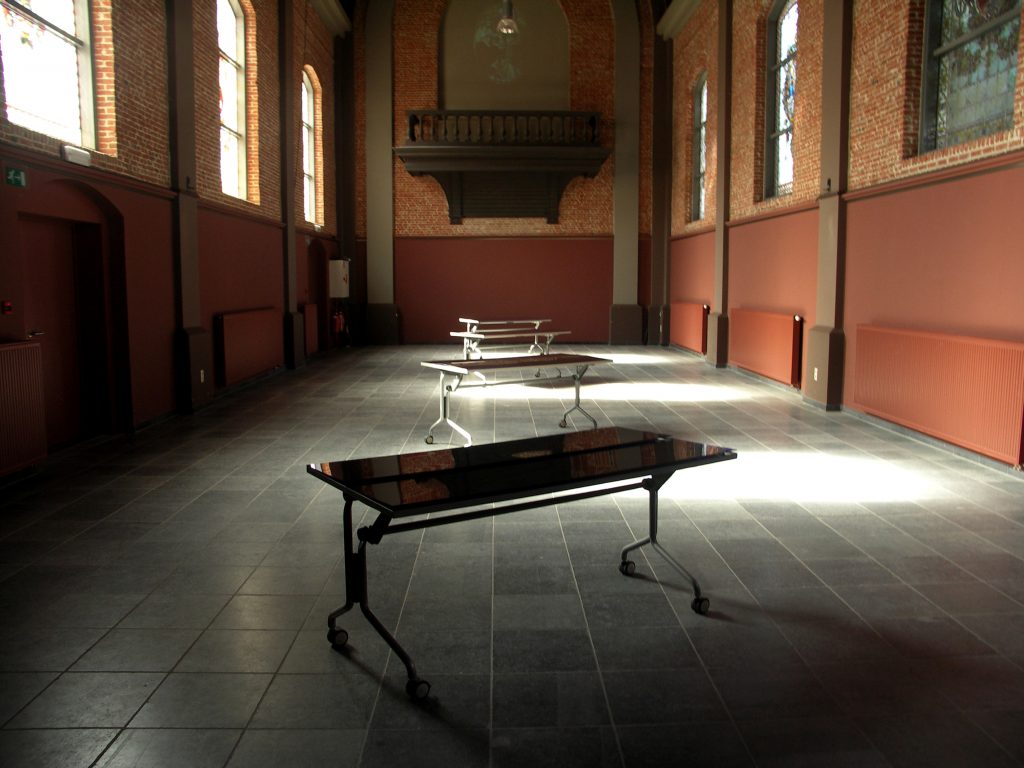
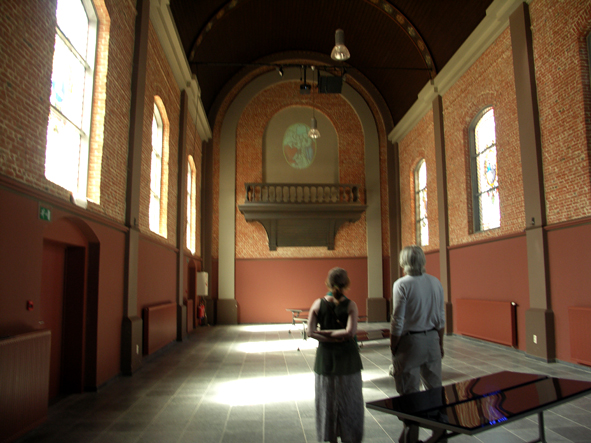
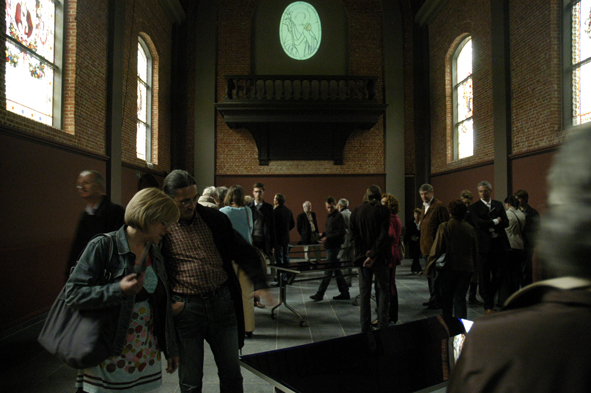
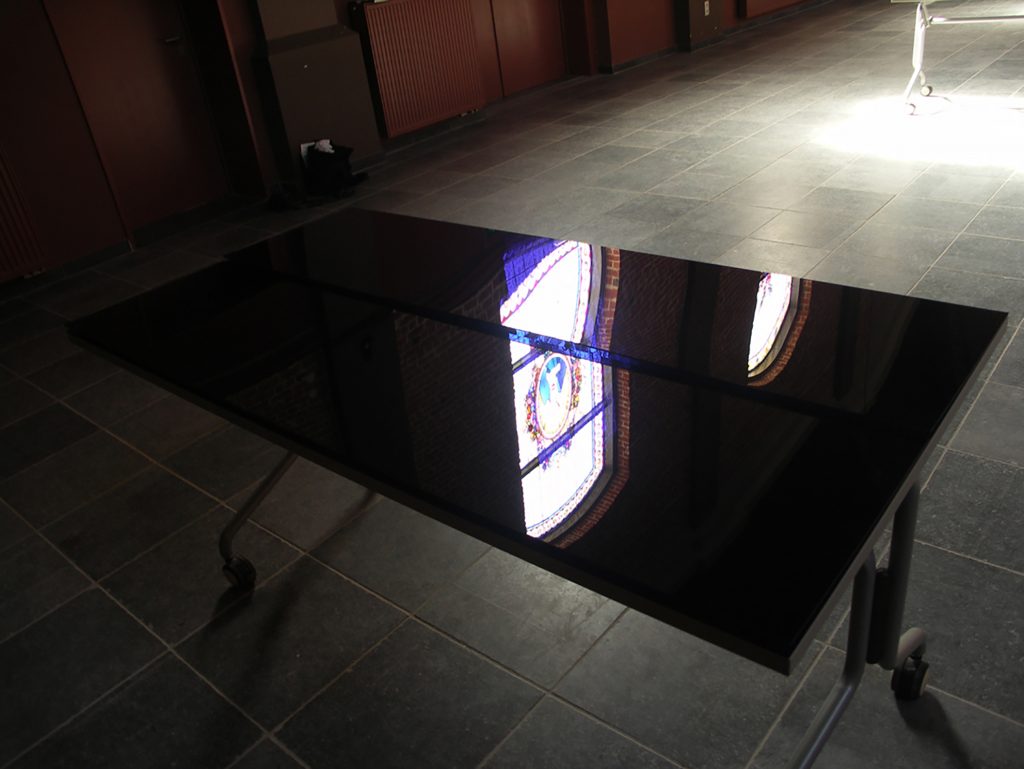
CC Ter Vesten, Beveren-Waas, Belgium 2010
Chapel Vrasene
4 tables/plexiglass/video installation
Stefaan Van Biesen
text to the exhibition – abstract
“… Monique Thomaes considers the architectural space as an integral part of her work.
A dialogue emerges between thinking, place and image. The artist improves space with a minimalistic zen attitude an lets the public participate its marvel.
For her installation she takes existing elements from the chapel, transforms them using light and projection and adds them back to the space.
So she filmed all the stained glass windows with increasing and decreasing exposure times – from dark to light to dark – and selected therefrom the ovals containing different personages and situations.
The video-montage, projected on the front-wall, resembles a portrait gallery: sculptures in a shining ebb and flow, as if the shining and disappearing of the visible were a metaphor for the changing and elusive light in space.
The same light coincides with the reflection of the seven stained glas windows on the four tables placed in the chapel and breaks on the blue plexiglass surface on the tables.
The image becomes an architectural abstraction: it is spread horizontally, exhibited and moved from the window to another place in space.
It is an invitation to look in another way to a space one thinks to know.”

